We crack open the collected edition of the Eisner nominated miniseries
Viewing: Blog Posts Tagged with: Grant Morrison, Most Recent at Top [Help]
Results 1 - 25 of 69
Blog: PW -The Beat (Login to Add to MyJacketFlap)
JacketFlap tags: the multiversity, DC, Grant Morrison, DC Comics, Top News, Comic Reviews, Add a tag
Blog: PW -The Beat (Login to Add to MyJacketFlap)
JacketFlap tags: Comics, DC, Breaking News, Publishers, Grant Morrison, Wonder Woman, Top News, Yanick Paquette, Top Comics, Add a tag
Action Comics, Animal Man, Batman, The Doom Patrol, The Invisibles and The New X-Men. Nobody in comics has a resume quite like Grant Morrison. The author has written so many incredible comic books stemming all the way back to the ‘80s. That’s why when the writer sometimes takes a little bit of time producing his next masterpiece, fans […]
Blog: PW -The Beat (Login to Add to MyJacketFlap)
JacketFlap tags: comics magazine, gary lieb, jon b cooke, Grant Morrison, Kibbles 'n' Bits, Mike Dawson, charles addams, Top News, free comics, the iron giant, Add a tag
§ I don’t often run Kickstarter checks, but I see Mike Dawson’s Rules for Dating my Daughter kickstarter is nearly fully funded after only a few days! Granted it was a pretty modest goal, but I’m glad to see a book of indie non fiction comics get this much support. Also, Mike, I told ya: […]
Blog: PW -The Beat (Login to Add to MyJacketFlap)
JacketFlap tags: Grant Morrison, Kindle, comixology, Digital Comics, Top Comics, Black Mask Studios, Add a tag
Add Blask Mask to the list of publishers who will be available on both ComiXology and Amazon’s Kindle Store. Starting today you can read titles such as We Can Never Go Home, Godkiller, Space Riders, Ballistic, The Disciples and upcoming titles Young Terrorists and Sinatoro by Grant Morrison and Vanesa del Rey. Black Mask launched a […]
Blog: PW -The Beat (Login to Add to MyJacketFlap)
JacketFlap tags: Comics, Grant Morrison, Wonder Woman, DC Comics, Earth One, SDCC '15, Multiversity, Batman: Black and White, Add a tag
By Harper Harris
Miss out on the ‘Grant Morrison: The Multiversity and Beyond‘ panel at this year’s San Diego Comic Con? Never fear! Hear Morrison talk to DC’s VP of Marketing John Cunningham about his ideas for The Multiversity and how the project took form, as well as info on his upcoming Wonder Woman: Earth One, Multiversity Too, and Batman: Black and White books! Morrison and Cunningham go pretty in-depth here, so feel free to grab your copies of the series and follow along, it’s a fun ride!
Blog: PW -The Beat (Login to Add to MyJacketFlap)
JacketFlap tags: Do Androids Dream of Electric Sheep?, Top News, Top Comics, Cyanide and Happiness, SDCC '15, Klaus, Comics, Grant Morrison, Boom Studios, Add a tag
Over the past few weeks, BOOM Studios has made a bevy of announcements to drum up excitement for their San Diego showings. It’s their tenth anniversary, and they’re celebrating in style.
First off, Grant Morrison will be writing Klaus, which is what Morrison describes as “Santa Claus: Year One.” He’ll be working with artist Dan Mora for the six issue run, focusing on developing the character’s Viking and Siberian mythological roots while shying away from the more corporate cola takes on the jolly red fellow. Morrison describes the book as an all-ages title, but I’m not really sure I believe him.
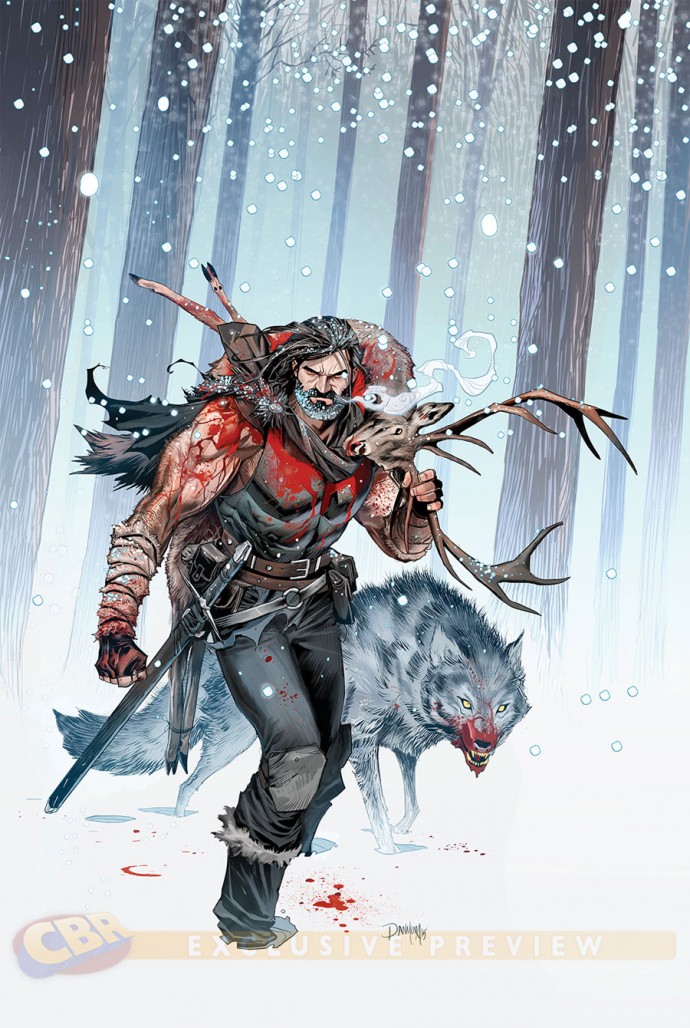
Then, we have Ollie Masters, best known for his work on Vertigo’s The Kitchen, who recently announced that he’ll be writing a new BOOM series in the vaguest way possible. Seems to be something about family and lies. Maybe it’s The Sopranos. Or Breaking Bad. Oh god I hope it’s Breaking Bad.
Not to be outdone, Mike Carey and Mike Perkins have released a teaser image for their upcoming BOOM series.
Returning to the realm of specificity, Kris Wilson, Rob DenBleyker, and Dave McElfatric, creators of the hit webcomic Cyanide and Happiness, will be releasing a collected edition of works through BOOM. This collection, entitled Stab Factory, will feature thirty new strips. Four of them are available now on Comics Alliance.
Finally, BOOM is working with Philip K. Dick’s estate to bring cartoonist Tony Parker’s 24 issue Eisner-nominated adaptation of Dick’s Do Androids Dream of Electric Sheep? back to print as a collected hardcover. Jay Shaw will provide the edition with a brand new piece of cover art. The collection will also feature essays from prolific comics professionals including Warren Ellis, Ed Brubaker, and Matt Fraction.
Blog: PW -The Beat (Login to Add to MyJacketFlap)
JacketFlap tags: Top Comics, Grant Morrison, Heavy Metal, Comics, Breaking News, Top News, Add a tag
Crazy comics mastermind Grant Morrison is at it again. Now that he’s finished his run on DC’s Multiversity, Morrison is turning his sights away from tights and will now focus his attention on Heavy Metal, the bimontly comics zine that introduced cartoonists like Moebius and H.R. Giger to the American scene. Beginning in February 2016, he will serve as editor to the magazine for a minimum of a year.
Morrison plans to produce comics and prose content for the magazine himself, but is also looking to recruit talent that will ultimately create something he hopes will be “unique and provocative, a bit more scary for people and challenging.”
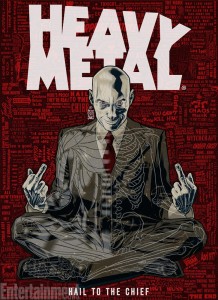
Ever the eclectic, Morrison has really made the past decade his own. He published his own textual account of American comics history in Supergods, hosted a convention where he got to make magic and sonic love with Gerard Way, brought the DC universe together for a big multiversal shish-kabob in Multiversity, and recently announced that he’d be writing Santa Claus’ origin story in Boom! Studios’ Klaus. Heavy Metal will be Morrison’s primary focus in 2016, but one can only assume he’s already eyeing his next perception-shattering project.
Check out Entertainment Weekly for more on the magazine and this wonderful bit:
Heavy Metal has always been a little bit dirty. Next year, it’ll get positively Filthy.
groan.
Blog: PW -The Beat (Login to Add to MyJacketFlap)
JacketFlap tags: Interviews, Books, Comics, Jack the Ripper, London, Grant Morrison, Bloomsbury, British Library, Ramsey Campbell, Lost Girls, Alan Moore, AARGH, Iain Sinclair, Michael Moorcock, Kickstarter, Joyce Brabner, Mad Love, Patricia Cornwell, steve moore, Top News, Dobby the House Elf, Crowdfunding, Robin Ince, Melinda Gebbie, from hell, Controversy!, Flann O'Brien, Golliwogg, gorse, Horse Hospital, John Clare, Kirsten Norrie, Richard Coles, Second Avenue Caper, Swandown, The Cardinal and the Corpse, The Communards, Toby Jones, The Infinite Monkey Cage, Walter Sickert, Add a tag
Previous parts of this interview: Part I – Steve Moore, River of Ghosts, The Show, and Twinkle Twinkle Little Star, and Part II – Punk Rock, Crossed, and Providence. Now read on…
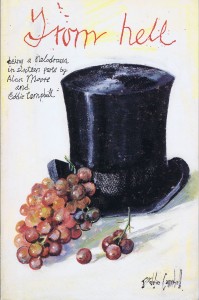 PÓM: A few other things… Yes, now. Have you been following any of the latest revelations on Jack the Ripper? Do you keep an eye on that?
PÓM: A few other things… Yes, now. Have you been following any of the latest revelations on Jack the Ripper? Do you keep an eye on that?
AM: [Laughs] No, because it’s all going to be bollocks.
PÓM: Oh yeah.
AM: Alright, I stand to be corrected, but what are the latest revelations on Jack the Ripper?
PÓM: Somebody claimed to have bought a scarf, a very expensive scarf…1
AM: Oh yeah, I read about that. And obviously at the time, that’s bollocks…
PÓM: Oh yes, absolutely and complete bollocks!
AM: And they’ve since proved that it’s bollocks – I think that they’ve just said that, no, there’s no connection at all between Catherine Eddowes and the stain on this scarf.
PÓM: I do remember thinking that they seemed to be in possession of an awful lot of information about DNA and all of that that seemed… unlikely.
AM: Unlikely at the time, yes. No no, that – these are always going to be non-starters. Alright, unless there is some brilliant piece of evidence waiting to be discovered that – how likely is that?
PÓM: I know. I just wondered if – ‘cause you did From Hell, I presume you still have some interest in the subject.
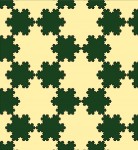 AM: Well, with From Hell, at the end of it, in The Dance of the Gull Catchers, there is that statement about – Look, how long can this go on? About Koch’s Snowflake2, about the increasing trivia applied around the crinkly edges of this case, but the area of the case cannot exceed the original events and consequently, new books about Jack the Ripper, they’re less about Jack the Ripper than they are about keeping the Jack the Ripper industry going, because it’s been quite lucrative for a few years, you know? And I honestly think that that is the truth.
AM: Well, with From Hell, at the end of it, in The Dance of the Gull Catchers, there is that statement about – Look, how long can this go on? About Koch’s Snowflake2, about the increasing trivia applied around the crinkly edges of this case, but the area of the case cannot exceed the original events and consequently, new books about Jack the Ripper, they’re less about Jack the Ripper than they are about keeping the Jack the Ripper industry going, because it’s been quite lucrative for a few years, you know? And I honestly think that that is the truth.
So, no, I tend to be dismissive of – every four or five years there will be ‘At last, the final truth!’ And it never is. And it’s very often preposterous, or a deliberate hoax. Or you’ll get, say, Patricia Cornwell, with her vandalisation of a Walter Sickert painting in the ridiculous hope that she could match the DNA to that on the letters received the police, which were not from the killer anyway.3
PÓM: I remember when the documentary was on the telly, I saw it was coming up…
AM: Yeah, I saw that, and I saw at the end of it, all she’d got was some footage of Walter Sickert being led out, probably in his eighties, to be filmed in a garden somewhere, and she said, ‘Yes, look at those eyes – pure evil.’ Ignorant woman.
PÓM: I remember she said something like ‘I knew as soon as I looked into his eyes that it had to be him.’4 And this is a woman who…
AM: That was all the evidence that she’d got, and – the thing is, that Patricia Cornwell is apparently supposed to be an actual real-life pathologist…5
PÓM: Yeah!
AM: …apparently cases in the American legal system have presumably depended upon her evidence – I hope she was doing a little bit more than looking in people’s eyes.
PÓM: I know! I have never been so disappointed with something on the television – in my life! Because I expected – because of who she was, and what she was, I expected this was going to be really incisive and good and interesting.
AM: I had read some of her books, so perhaps I wasn’t expecting quite as much as you were.
PÓM: [Laughs] Fair enough!
AM: I read a few of her books with the beautiful woman pathologist…6
PÓM: Oh, I know who you mean…
AM: …who somehow always ends up at the centre of every case. She’s always the one that the serial killer gets an obsession with, even though there’s no way in the real world that he would ever know who she was. She’s always smarter than the police. And then when I found out that Patricia Cornwell was herself a pathologist at some point I thought, ‘Yes, I think I can see where this is going.’
PÓM: Yes. It did seem as well the whole Jack the Ripper thing was kind of because her father had left home when she was five, and there were some elements of that in there, which is where it started getting strange.
AM: Yeah, well a lot of these people who get obsessed with true crimes, they’re – sometimes, they can be working out something in their own psychology, rather than anything to actually do with the crime that they are officially dealing with. I haven’t really taken a great deal of interest in Jack the Ripper since finishing From Hell – probably more in Psychogeography and London.
 PÓM: I must say, we’ve been spending a fair bit of time in London, Deirdre and myself. We were over there last week. We went to see – do you know the Reverend Richard Coles?7
PÓM: I must say, we’ve been spending a fair bit of time in London, Deirdre and myself. We were over there last week. We went to see – do you know the Reverend Richard Coles?7
AM: Oh yes, I met him once. I met him with Robin Ince.8
PÓM: Yeah. He was doing a thing in the British Library, he was doing – because he’s got a first volume of his autobiography out – another good Northampton lad!
AM: Is he? Yeah, he’s from out in the outskirts, I think he’s from one of the villages.
PÓM: That’s where he’s being a Rev these days. A thoroughly lovely man.
AM: He seemed really nice when I met him, and of course he was great in The Communards.
PÓM: Well, he was. He was. Not a great dancer, but a charming human being. But, yeah, I’ve recently joined the British Library, which is completely fantastic.9 I’m doing research into Flann O’Brien, and The Cardinal and the Corpse, all of that.
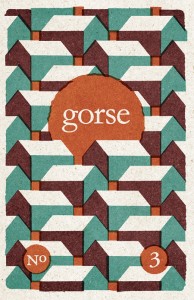 [There’s actually a part of the interview missing here, because I felt it was so far removed from having even the slightest relevance to this particular site that it was best elsewhere. It concerns English writer Iain Sinclair‘s 1992 documentary film The Cardinal and the Corpse, which almost no-one has seen besides Alan and myself. It also peripherally concerns Irish writer Flann O’Brien, about whom I have been spending quite a lot of time reading and researching of late. The interview is here, on the gorse website. By absolutely no coincidence whatsoever I have an essay on Flann O’Brien in gorse #3, entitled The Cardinal & the Corpse, A Flanntasy in Several Parts, which I commend to you all. End of outrageous and gratuitious self-promotion.]
[There’s actually a part of the interview missing here, because I felt it was so far removed from having even the slightest relevance to this particular site that it was best elsewhere. It concerns English writer Iain Sinclair‘s 1992 documentary film The Cardinal and the Corpse, which almost no-one has seen besides Alan and myself. It also peripherally concerns Irish writer Flann O’Brien, about whom I have been spending quite a lot of time reading and researching of late. The interview is here, on the gorse website. By absolutely no coincidence whatsoever I have an essay on Flann O’Brien in gorse #3, entitled The Cardinal & the Corpse, A Flanntasy in Several Parts, which I commend to you all. End of outrageous and gratuitious self-promotion.]
PÓM: Are you doing some series of things with Joyce Brabner?10
AM: There is a work that I’m – I’m doing a work with Joyce, but I’m starting that at the moment. I can’t tell you much about that, because it will be sometime this year – I’m more or less starting work on it now, over the next – probably over the weekend, and it’s likely to be something to do with identity, but I really can’t tell you much more than that – I’ve got my ideas, but they’re not really well formed enough yet, but later in the year I’ll be able to fill you in more with that.
PÓM: Ok, cool. Sure, we’ll talk again, undoubtedly. And I think I’m going to wrap it up – I must say, when you’re talking about doing Swandown, and things like that – that’s the thing with the pedalo, isn’t it? With the swan-shaped pedalo?11AM: That is one of the sweetest films I’ve ever seen, and not just because I’m in it. In fact, I think that my contribution is one of the more negligible aspects of it. It’s English poetry. It shows you that there is no landscape that cannot be made poetic with the addition of a big plastic swan. And in fact, since then I also earlier this year – no, last year, last year. Spring or Summer, I went and filmed a bit with Andrew and Iain for their next project, which is called By Our Selves, and it’s all about John Clare12, and it’s got Andrew mucking about dressed as a straw bear, and recreating John Clare’s limping walk from Epping Forest and Matthew Arnold’s mental asylum back to Helpston in Northampton. Eighty miles or something, where he was eating grass and hallucinating. Yeah, so Andrew and Iain came up to Northampton, I spent a lovely afternoon sitting pretending to be a version of John Clare. They’ve got Toby Jones
13 doing all the heavy lifting in terms of being John Clare, so that should be – ‘cause he’s an incredible actor…
Alan Moore and a Straw Bear, borrowed from here
AM: That stuff is the best. Things like that that just come out of the blue. I still enjoy me comics work, I still enjoy the ordinary writing that I do, but – the little surprising things like that, that I’ve not done before, that are a great afternoon out, seeing lovely people, and knowing that it’s going to end up as a really poetic cinematic document, yeah, I am having a lot of fun with that, when it happens. It’s irregular, but charming when it does.
PÓM: Well, good. And I think that’s it. Is there anything that you’re doing that I should know about that I don’t know about?
AM: Yeah, probably. Whether I actually consciously know about it, is the big question. There must be some – did you hear about The Dying Fire?
PÓM: Nooooo…
AM: This was a book that I’ve just brought out from Mad Love Publishing, it’s the collected poetry of Dominic Allard…14
PÓM: Yes, I did, because I have a copy inside. Yes, of course.
 AM: Ah right. With the big introduction. That seems to be going quite well, and Dominic seems a bit stupefied by the sudden exposure – mind you, Dominic seems a bit stupefied by most things, it has to be said. But, no, that was really good, taking the books down to him, and giving him a load of copies, so there’s that. What else have I been doing? I’ve been reading through Steve Moore’s journals, which I collected from his house, and that’s bittersweet. There’s some incredible information in there, things that I’d forgotten about. Just day-by-day stuff in Steve’s life, but he was meticulous about listing it all.
AM: Ah right. With the big introduction. That seems to be going quite well, and Dominic seems a bit stupefied by the sudden exposure – mind you, Dominic seems a bit stupefied by most things, it has to be said. But, no, that was really good, taking the books down to him, and giving him a load of copies, so there’s that. What else have I been doing? I’ve been reading through Steve Moore’s journals, which I collected from his house, and that’s bittersweet. There’s some incredible information in there, things that I’d forgotten about. Just day-by-day stuff in Steve’s life, but he was meticulous about listing it all.
PÓM: Do you do that? Do you keep a journal, or anything like that?
AM: No I don’t. And Steve’s journals are part of the reason why I don’t.
PÓM: Oh yes, one other thing I did want to ask you. Do you remember our last interview? That was the written interview.15
AM: Yes…?
PÓM: Did you ever get any feedback on that, or did you hear – there was a certain amount of…
AM: I don’t know if I did or not, Pádraig. Where would I have got it from?
AM: Well, indeed. There was huge amounts of hoopla on the internet about it, which – it was interesting. It was…
AM: Oh, that was the stuff about the Golliwogg?
PÓM: Yes, the Golliwogg, and…
AM: Yes, that was when I wrote my – Yes, I remember – that was when I spent the Christmas writing the rejoinder?
PÓM: Yes, yes!
AM: Yeah, I didn’t hear much about it, to tell the truth, once I’d got it out of me system, and I thought that the issues had been addressed, I just kind of let it go. Why, did – you say that there was a lot of furore?
PÓM: Oh, I had – when I put it up on my blog, and it just spread out everywhere, and I was getting hundreds of comments and replies. It was all quite fascinating – it genuinely didn’t bother me in any way, shape, or form. The people who said rude things, I just deleted them, because people have strange notions about what the right to free speech actually means. And it was just – it was interesting – it was great. It was a fantastic piece of, em…
AM: Invective?
PÓM: I was going to say a fantastic piece of writing, of a thing to put out there, and I was delighted to be in that way involved with it but, yes, a fine piece of invective, and all the better for it.
AM: I was talking with somebody who read it, and he was saying ‘I think you might have revived a kind of literary form, that has not been really practiced since the eighteenth century,’ the really crushing, bitter, stinging satire, if you will. Yeah, I was quite pleased with it. After doing it, I tended to put it out of me mind.
PÓM: No harm in that. I must say…
AM: Was any of the response positive?
PÓM: Oh yeah! Oh Christ, yes! Plenty of it. There was lots of people who are just happy to do down anything that turns up, but there was a lot of people that thought you gave someone a kickin’ that deserved a kickin’.
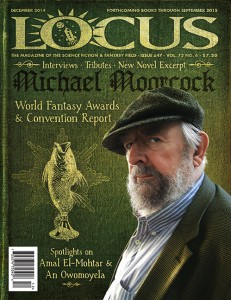 AM: Well, that’s good. I had a very nice comment from Ramsey Campbell16. He said, pretty much, ‘Right on, Alan,’ so that was nice. I did see, in the Michael Moorcock issue of Locus that came out recently that Mike, he was talking a little bit about Grant Morrison as well, just because he was asked some question about why he doesn’t encourage other people to do Jerry Cornelius stories these days, which apparently does rather connect up with some of Morrison’s work. Ah, I thought it needed saying, and it was better out than in.
AM: Well, that’s good. I had a very nice comment from Ramsey Campbell16. He said, pretty much, ‘Right on, Alan,’ so that was nice. I did see, in the Michael Moorcock issue of Locus that came out recently that Mike, he was talking a little bit about Grant Morrison as well, just because he was asked some question about why he doesn’t encourage other people to do Jerry Cornelius stories these days, which apparently does rather connect up with some of Morrison’s work. Ah, I thought it needed saying, and it was better out than in.
PÓM: Well, indeed. Sure, it’s all part of life’s rich pageant.
AM: Absolutely.
AM: Mel’s fine – oh, yes, that’s something that I should probably tell you about. Mel is preparing for her first spectacular exhibition. This will be at the Horse Hospital in Bloomsbury.
PÓM: Oh, I love Bloomsbury, I have to say. I could live in Bloomsbury.18
AM: Have you been to the Horse Hospital?
PÓM: I don’t think we have, no.
AM: Well, I did a gig there with the lovely Kirsten Norrie19 – which also, she appears with me in that, By Our Selves, the John Clare film. But I did a gig where Kirstin was singing, and I was reading a part of Jerusalem, so I went to the Horse Hospital, and in there, I knew that our gig was underground, in the basement, and I thought, ‘Oh, this is a bit weird, there’s no stairs, there’s just these ramps.’ And then I thought ‘Horse Hospital!’
But it’s a lovely little space, and I believe that Mel will be doing her exhibition there on April the 10th, and there’s tons and tons of drawings, there’s seven or eight of her paintings, and I believe that there might be some bronze busts that she’s done of the three main characters from Lost Girls. So, if anyone reading this happens to be in the Bloomsbury area around April 10th this year, they could do worse than to drop in.
PÓM: I shall be sure to tell people.
AM: OK, you take care, like I say, Pádraig, and love to Deirdre – and that’s what Mel’s doing, she’s preparing that.
FOOTNOTES:
1On the 6th of September 2014 the Daily Mail carried a story that DNA evidence had been found on a scarf – allegedly once the property of Catherine Eddowes, the fourth of the five ‘canonical’ victims of the serial killer known as Jack the Ripper, whose exploits set Victorian London into a frenzy of speculation which has still not died away – which proved that the killer was actually Polish immigrant Aaron Kosminski. The story is here, although you really also need to read the refutation, here, as well.
2I refer you to the Koch’s Snowflake page on Wikipedia, because they explain it better than I ever will.
 3Crime writer Patricia Cornwell wrote a book called Portrait of a Killer — Jack the Ripper: Case Closed, published in 2002, where she claimed that British painter Walter Sickert was the Whitechapel murderer, and went to extraordinary – and, frankly, borderline insane – lengths to prove it, including supposedly cutting up one of his paintings in an effort to find clues of some kind. There’s an excellent piece about it on the Casebook: Jack the Ripper website, here. In the meantime, Cornell has written more on the subject, a Kindle Single called Chasing the Ripper, published in 2014, and available here, if you’re feeling brave.
3Crime writer Patricia Cornwell wrote a book called Portrait of a Killer — Jack the Ripper: Case Closed, published in 2002, where she claimed that British painter Walter Sickert was the Whitechapel murderer, and went to extraordinary – and, frankly, borderline insane – lengths to prove it, including supposedly cutting up one of his paintings in an effort to find clues of some kind. There’s an excellent piece about it on the Casebook: Jack the Ripper website, here. In the meantime, Cornell has written more on the subject, a Kindle Single called Chasing the Ripper, published in 2014, and available here, if you’re feeling brave.
4 Yes, she really says something almost exactly like that. Here‘s the relevant bit from the documentary, courtesy of those nice people over at YouTube.
5Patricia Cornwell isn’t actually a ‘real-life pathologist,’ although she did work in the Office of the Chief Medical Examiner of Virginia for six years, first as a technical writer and then as a computer analyst, so had at least some input into their findings, one imagines.
6Dr Kay Scarpetta, the protagonist of twenty-two Cornwell novels thus far.
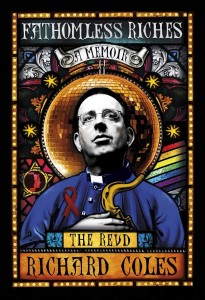 7The Reverend Richard Coles is a Church of England priest, currently working as the parish priest of St Mary the Virgin, Finedon, Northampton, in the Diocese of Peterborough. He was previously in The Communards with Jimmy Somerville, formerly of The Bronsky Beat, with whom Coles had also occasionally played. He is openly gay and lives with his civil partner in a celibate relationship, although they have four dachshunds, and he remains the only vicar in Britain to have had a Number 1 hit single. Above and beyond all that, he does regular appearances on the television and radio in Britain, and is a thoroughly lovely human being. He did an appearance in the British Library on Friday the 20th of February 2015 to publicise his autobiography, Fathomless Riches, which I attended with my wife Deirdre.
7The Reverend Richard Coles is a Church of England priest, currently working as the parish priest of St Mary the Virgin, Finedon, Northampton, in the Diocese of Peterborough. He was previously in The Communards with Jimmy Somerville, formerly of The Bronsky Beat, with whom Coles had also occasionally played. He is openly gay and lives with his civil partner in a celibate relationship, although they have four dachshunds, and he remains the only vicar in Britain to have had a Number 1 hit single. Above and beyond all that, he does regular appearances on the television and radio in Britain, and is a thoroughly lovely human being. He did an appearance in the British Library on Friday the 20th of February 2015 to publicise his autobiography, Fathomless Riches, which I attended with my wife Deirdre.
8Robin Ince is an English Science-Comedian and renowned Atheist. He is involved with the occasionally annual Christmastime event Nine Lessons and Carols for Godless People, as well as the radio programme The Infinite Monkey Cage, both of which have included Alan Moore on occasion.
9If you think I’m being overly mean in describing the Rev. Coles as a bad dancer, I suggest you go look at this video of The Communards performing Never Can Say Goodbye
, and make up your own mind. The British Library, by the way, is one of my favourite places in the whole wide world. If Heaven is not very like it, I shall be very disappointed.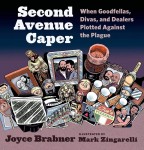 10Joyce Brabner is an American comics writer, and the widow of the late Harvey Pekar. She has collaborated with Moore before, on Brought to Light, and on Real War Comics. Most recently she has written the non-fiction graphic novel Second Avenue Caper: When Goodfellas, Divas, and Dealers Plotted Against the Plague, about the real-life efforts of people caught up in the AIDS epidemic in New York in the early 1980s. It’s good stuff, and you all need to go read it.
10Joyce Brabner is an American comics writer, and the widow of the late Harvey Pekar. She has collaborated with Moore before, on Brought to Light, and on Real War Comics. Most recently she has written the non-fiction graphic novel Second Avenue Caper: When Goodfellas, Divas, and Dealers Plotted Against the Plague, about the real-life efforts of people caught up in the AIDS epidemic in New York in the early 1980s. It’s good stuff, and you all need to go read it.
 11Swandown is a 2012 film in which Andrew Kötting and Iain Sinclair pedaled a swan pedalo down the Thames from the Hastings, on the sea, to Hackney, in London, occasionally joined by people like Alan Moore and comedian Stewart Lee. Look, I promise I’m not making this stuff up, and there’s a photograph to prove it. From left to right we have Lee, Moore, Kötting, and Sinclair.
11Swandown is a 2012 film in which Andrew Kötting and Iain Sinclair pedaled a swan pedalo down the Thames from the Hastings, on the sea, to Hackney, in London, occasionally joined by people like Alan Moore and comedian Stewart Lee. Look, I promise I’m not making this stuff up, and there’s a photograph to prove it. From left to right we have Lee, Moore, Kötting, and Sinclair.
12John Clare, known as The Northamptonshire Peasant Poet, was the writer of collections like Poems Descriptive of Rural Life and Scenery and Village Minstrel and other Poems. The film By Our Selves is in part based on Iain Sinclair’s book The Edge of the Orison: In the Traces of John Clare’s ‘Journey Out of Essex’. More information can be found on the By Our Selves Kickstarter page. It was successfully funded, and the project is ongoing.
 13Toby Jones is an excellent English actor. Amongst other things, he has done the voice of Dobby the House Elf in the Harry Potter films, appeared in an episode of Doctor Who, and had parts in films like Captain America: The First Avenger, Tinker Tailor Soldier Spy, The Hunger Games, and Captain America: The Winter Soldier, and many many more.
13Toby Jones is an excellent English actor. Amongst other things, he has done the voice of Dobby the House Elf in the Harry Potter films, appeared in an episode of Doctor Who, and had parts in films like Captain America: The First Avenger, Tinker Tailor Soldier Spy, The Hunger Games, and Captain America: The Winter Soldier, and many many more.
14Mad Love Publishing is a publishing company Moore set up in the late 1980s with others, originally to publish AARGH (Artists Against Rampant Government Homophobia), and subsequently the first two issues of Big Numbers. The company had a long hiatus, but has reappeared recently as the publisher of Dodgem Logic, and most recently of The Dying Fire, a poetry collection by Moore’s old school friend Dominic Allard. The Northants Herald & Post reported on the story here.
15The interview referred to hear, which Alan doesn’t at first realise I’m referring to, is the infamous Last Alan Moore Interview?, which some of you may have already read, or at least read about. It has, to date, a bit over 100,000 views, and 350 replies, which is not too bad for the first post on a new blog!
 16Ramsey Campbell is an English horror writer who has written numerous novels, including The Doll Who Ate His Mother, The Face That Must Die, and The House on Nazareth Hill, as well as numerous collections of short stories. He has a list of awards for his work as long as your arm, including the British Fantasy Award, the World Fantasy Award, the International Horror Guild Award, and the Bram Stoker Award.
16Ramsey Campbell is an English horror writer who has written numerous novels, including The Doll Who Ate His Mother, The Face That Must Die, and The House on Nazareth Hill, as well as numerous collections of short stories. He has a list of awards for his work as long as your arm, including the British Fantasy Award, the World Fantasy Award, the International Horror Guild Award, and the Bram Stoker Award.
17Melinda Gebbie is an American comics creator, now settled with her husband, Alan Moore, in the heart of England. They’ve worked together on various things, including Lost Girls.
18Bloomsbury is the bit of London that contains the British Museum, occasional headquarters of the Victorian version of the League of Extraordinary Gentlemen, and the British Library. It’s full of culturally wonderfully stuff, parks with friendly squirrels in, and lots of Blue Plaques to all sorts of writers and the like. I recommend you go visit, at least once in your life. The exhibition in the Horse Hospital runs until the 9th of May, so there’s time to see it yet.
19Kirsten Norrie is a Scottish artist and musician, and a member of Wolf in the Winter, an international performance collective.
Blog: PW -The Beat (Login to Add to MyJacketFlap)
JacketFlap tags: Multiversity, Comics, Breaking News, Grant Morrison, Top News, Doug Mahnke, Top Comics, Add a tag
Writer:Grant MorrisonPenciller:Doug MahnkeInkers:Christian AlamyMark IrwinKeith ChampagneJaime MendozaColorists:Gabe EltaebDavid Baron
Comics aren’t meant to make readers feel guilty, but The Multiversity: Ultra Comics #1 paints the fan as the individual leading the protagonist to his ultimate fate. This is it – the haunted story teased since the first installment of Author Grant Morrison’s magnum Multiversity opus. The Multiversity as it stands is my favorite ongoing series from superhero publisher DC, it’s something that’s hard to believe anyone at the Big Two could even think about publishing. Morrison has been circling a sphere of comics self awareness with titles like Animal Man for several years now, and this feels like the natural progression of all those titles. Even though the writer continues to discover new things about self reflexive superheroes, he never feels like he’s repeating himself in this work. The ideas of the Psycho Pirate and Animal Man being erased from continuity is far different from than the mechanically engineered Ultra Comics presented in this work.
Standing on it’s own merits devoid of what came before with the series, is this book good?
Yes. The story can simply be read without that context via the playful opening from Morrison and the exceptional Doug Mahnke (who’s pencils have been sorely absent from Green Lantern.) Nearly every idea within this saga is a reintroduced story beat hatched from the DC vault. Still, this hero (Ultra Comics) emerged from pretty obscure roots and builds on nearly everything that Morrison has done with the DC Universe. There is even a reference to Final Crisis directly in this title showing that Morrison takes this absurdist pillar of the DC landscape that he has built extremely seriously.
The first thing that catches my eye about The Multiversity: Ultra Comics #1 is the Doug Mahnke cover. The piece is elegantly designed yet filled with utter madness reflecting some of the best covers from tales long ago. The text reading “YOU MUST NOT READ THIS COMIC,” should be the first clue that this is one of the most subversive and enthralling DC books you’re going to find this side of Convergence. What follows this is stirring image complete with a warning from Ultra Comics (our protagonist) to not finish this issue for the sake of his own very life. The storytelling stakes are set in this issue, and if we the reader choose to continue reading we’re to believe that the very fate of Ultra Comics has been decided. That’s a lot to take in over the span of just one story, and my own personal guilt regarding what happens next led is my own fault.
The first issue of The Multiversity arguably mixed the most concepts and characters and introduced us to the primary threat featured in this story – it’s essential reading to anyone left scratching their heads with this issue. This can be read stand alone as mentioned earlier, but to enjoy this text to the fullest a background in Morrison DC’s work is ideal. Ultra Comics is a book was first introduced via the live dissection from a Monitor within that issue. As a result, don’t expect this comic to be an easy read without the context of the broader series. It’s tempting to say that the threat of this book will be capitalized on as the baddie for the full Multiversity event, but Morrison has trained readers not to look at his work with such a clear lens. The Gentry are not everything that caused the bleakness in Multiversity – as the Multiversity Guidebook clearly articulated.
Mahnke’s storytelling skills haven’t missed a beat. The artist perfectly captures the detailed linework and impossibly huge facial expressions that make this work something truly special. His haunting images are best utilized in the context of horror, which this series arguably falls under. The villains contained within this story are terrifying, silly, and then maddening all in the context of one issue. Mahnke is called upon to be a really versatile artist in this experience, and does a great job on the static rendition of Ultra Comics nobly glimpsing at the reader. Also called upon are several other small flashes of violence with an exploration into the brutality buried deep within superheroes. Christian Alamy, Mark Irwin, Keith Champagne, and Jamie Mendoza bring this issue to a total of four inkers in this oversized. There are the occasional moments of inconsistency here, but overall this is some admirable work from the four mostly blending into each other and not detracting from the reader experience too much. The important part of the art in this issue is that Mahnke was allowed to draw a riveting horror comic.
There are so many different ideas crammed into this one piece of writing. The self reflexive asides kept the plot from becoming too complicated or too pedestrian. The buffer of Ultra Comics explaining his bizarre inner thoughts to the reader perfectly bring casual fans into the strange world of the title. There are so many different ways in which the story engages with readers, whether it be through Ultra Comics speech patterns, inner thoughts, dialogue trees, word balloons, and even meta-commentary within the context of the work itself.
To say much more about this story would spoil the delightful surprises waiting inside for readers to engage with. The Multiversity: Ultra Comics #1 is the only comic that ever melted off my face and left me in charge of the fate of my new favorite superhero.
I’m sorry Ultra Comics.
Blog: PW -The Beat (Login to Add to MyJacketFlap)
JacketFlap tags: Comics, DC, Meta, Breaking News, Grant Morrison, Top News, Doug Mahnke, the multiversity, Christian Alamy, Ultra Comics, Add a tag
Via Paste Magazine, who also scored a great interview with Grant Morrison about the eighth chapter of his critically acclaimed The Multiversity, here is a five page preview of this week’s reunion between Morrison and his Superman Beyond collaborators Doug Mahnke and Christian Alamy: The Multiversity: Ultra Comics #1
Given that Superman Beyond is one of my favorite Morrison comics ever, it’s no surprise that I’m looking forward to just what this dreaded comic, that’s appeared in the majority of The Multiversity‘s previous chapters as a corrupting object, will offer.
If my eyes turn red and I start attacking all of my loved ones, you’ll know who to blame.
As an additional note, when speaking with Paste at the above link, Morrison made mention of the team’s biggest influence for the new issue:
One more thing is that Ultra Comics was inspired by the 1970s head comics. I don’t know if you’ve ever read Jim Starlin’s Warlock or Captain Marvel. I grew up on that. Back in the day, people like Starlin would come back from Vietnam and did these fantastic allegorical kind of Pilgrim’s Progress-style superhero comics. So I think Ultra Comics was my and Doug Mahnke’s attempt to almost create one of those cosmic comics of the ‘70s. Everything is allegorical. Everything is a metaphor. Everything is some psychological state. I will mention that, because those guys were a big inspiration for this particular issue.
THE MULTIVERSITY: ULTRA COMICS #1
Written by GRANT MORRISON
Art by DOUG MAHNKE and CHRISTIAN ALAMY
Cover by DOUG MAHNKE
1:10 B&W Variant cover by DOUG MAHNKE
1:25 Variant cover by DUNCAN ROULEAU
1:50 Variant cover by YANICK PAQUETTE
1:100 Variant cover by GRANT MORRISON
On sale MARCH 25 • 48 pg, FC, $4.99 US • RATED T
The penultimate chapter of the greatest adventure in DC’s history is here!
The acclaimed FINAL CRISIS team of Grant Morrison and Doug Mahnke reunite for a story so big it could only take place in the real world – that’s right, Earth-33 is back!
With the Multiverse under attack, a team of scientists create one final savior to take on the otherworldly threat…and its name is Ultra Comics! Literally held in your hands, one being will attempt to halt the annihilation of creation – and you, the reader, will have a front-row seat as you become an integral part of the resistance!
It’s another exciting, experimental story told by two of today’s top creators! You won’t want to miss this exciting issue which acts as chapter eight of THE MULTIVERSITY storyline.
Blog: PW -The Beat (Login to Add to MyJacketFlap)
JacketFlap tags: Movies, Grant Morrison, Top News, James Gunn, we3, Add a tag
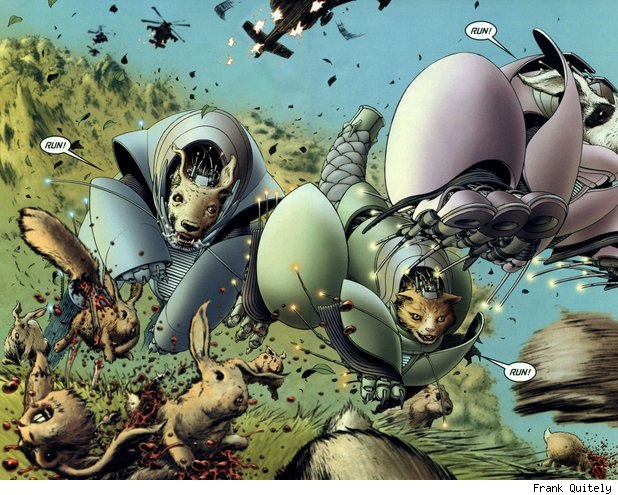
Over the weekend, he had a little spare time, and director James Gunn answered a bunch of question on FB, summarized here. The one thing the leapt out at us was this:
Gunn repeatedly reiterated his desire to direct a movie version of Grant Morrison’s Vertigo series “We3,” answering a question about a dream project he’d have trouble making reality. He also referenced his oft-cited dreams of bringing “Hit Monkey” to the big screen, something he apparently attempted to actually do after “GotG.” “Well I tried to direct Hit Monkey before Gotg2. Does that count?” he responded when asked what other superhero films he’d would’ve chosen to direct.
We3 by Grant Morrison and Frank Quitely is an updated “incredible journey” where a cyborg kitty, puppy and bunny escape attempt to revenge themselves on their captors. It’s one of the most concise and powerful comics of Morrison’s career, with incredible visuals by Quitely that are heartstopping and heartbreaking. You can take your Pax Americana and annotate it to death; We3 is a real masterpiece that still makes me cry.
Despite being the raw materials for a film that would be spectacular, dramatic and exciting, We3 has been kicking around in development in Hollywood for a loooong time, alas, with no progress. But I’m with Gunn on this—while it may be only a pipedream, the animal-loving director would be the PERFECT person to make this film at long last. Doooooo it.
In other news, Gunn revealed that Marvel won’t be doing a presentation at Comic-Con 2015—doubtless because D23, their own Comic-Con, is a few weeks later and they’re saving Star Wars for their own show. BRUTAL. But Kevin Tsujihara just breathed a sigh of relief.
In cuter MCU news, Chris Evans and Chris Pratt followed up on their Super Bowl bet with Evans donning his Captan America costume to visit a children’s hospital. (Pratt did the same with Starlord in Boston after the Patriots beat the Seahawks about five million weeks ago.)
Meeting Captain America and Star-Lord is an experience our patients will always remember. #TwitterBowl pic.twitter.com/iDJWJ4UGbs
— Seattle Children's (@seattlechildren) March 8, 2015
In even more cute news, Chris Hemsworth appeared on SNL and appear in a sketch as Thor of course, complete with real Aussie accent. It’s the crawls that make this though. DAMAGE CONTROL.
But anyway, beore getting befuddled with cuteness, JAMES GUNN WE3 YES YES YES.
Blog: PW -The Beat (Login to Add to MyJacketFlap)
JacketFlap tags: Breaking News, Grant Morrison, Previews, DC Comics, jim lee, Top News, Freedom Fighters, the multiversity, DC, Add a tag
The Multiversity has easily been among the best of DC Comics’ output since it debuted last August, and with each succeeding issue, it keeps getting better and better. Embracing everything that is weird and wonderful about the DC Universe has made it an utterly unique experience, with its most recent Guidebook issue even being hailed by Robot 6 as the “most DC Comic ever”.
Despite lots of critical acclaim that has it standing shoulder to shoulder with other great superhero comics like Ms. Marvel, the one thing that Morrison’s opus hasn’t quite done is rack up massive sales. They’ve been moderately successful, but slowly diminishing to where Thunderworld sold just under 48,000 copies (and the Guidebook selling under 39,000 per Comichron)
But if there’s one creator that can spike sales with some level of frequency, it’s Jim Lee. He’ll teaming up with Morrison for next week’s Mastermen, which focuses on the Nazi Justice League ruled Earth 10 and the Freedom Fighters.
Via Buzzfeed, here’s a preview of the upcoming issue:
THE MULTIVERSITY: MASTERMEN #1
Written by GRANT MORRISON
Art and cover by JIM LEE and SCOTT WILLIAMS
1:10 B&W Variant cover by JIM LEE
1:25 Variant cover by AARON KUDER
1:50 Variant cover by YANICK PAQUETTE
1:100 Variant cover by GRANT MORRISON
On sale FEBRUARY 18 • 48 pg, FC, $4.99 US • RATED T
Superstar writer Grant Morrison joins legendary artist Jim Lee on Earth-10 for one of the most dynamic, action-packed issues of this entire world-shattering series – THE MULTIVERSITY: MASTERMEN!
Imagine a world where the Nazis not only won World War II but went on to direct world culture for the next 60 years with the help of an orphaned, alien super-weapon known as Overman! But hope is not lost! Rising from the ashes of oppression are a diverse band of heroes raging against the fascist regime – a band of heroes known as THE FREEDOM FIGHTERS!
What nightmarish parallel worlds haunt the dreams of Overman? Who is the mysterious figure called Uncle Sam? And when the dust settles, will the actions of Phantom Lady, Black Condor, Human Bomb, Doll Man and The Ray be enough to stop Leatherwing, Blitzen and the other “heroes” of Earth-X?
Learn all this and more in this exciting issue that acts as chapter seven of the critically acclaimed MULTIVERSITY storyline
Blog: PW -The Beat (Login to Add to MyJacketFlap)
JacketFlap tags: Top News, Top Comics, Nameless, Reviews, Comics, Image, Breaking News, Publishers, Grant Morrison, Add a tag
 With a conscious effort to stray away from superheroes, author Grant Morrison is taking even more chances than usual in the comics world. Even Multiversity, his only DC Comics project at the moment is bending the traditional superhero narrative into the world of psychadelics. Annihilator from the Legendary Comics imprint is a great example of taking chances, spinning the expectations of critics, and defying genre. In the same vein as Annihilator, The Filth, and 2012’s Happy! mini-series comes a comic entitled Nameless. A few outlets have drawn some comparisons between Annihilator and Nameless in that they are similar stories with different tones and ideas melded by each artist. The script for Nameless in particular seems tailored for Author Chris Burnham’s special brand of lunacy.
With a conscious effort to stray away from superheroes, author Grant Morrison is taking even more chances than usual in the comics world. Even Multiversity, his only DC Comics project at the moment is bending the traditional superhero narrative into the world of psychadelics. Annihilator from the Legendary Comics imprint is a great example of taking chances, spinning the expectations of critics, and defying genre. In the same vein as Annihilator, The Filth, and 2012’s Happy! mini-series comes a comic entitled Nameless. A few outlets have drawn some comparisons between Annihilator and Nameless in that they are similar stories with different tones and ideas melded by each artist. The script for Nameless in particular seems tailored for Author Chris Burnham’s special brand of lunacy.
With an immoral character being introduced to a world he never knew existed, could this comic be carrying too many ideas echoed in Morrison’s other comics work?
Any tale by the author is nearly impossible to summarize in one paragraph, but this one involves an action story heavily influenced by the writer’s previous works with a certain sinister corporation (more on that later.) There is an explanation into strange and obtrusive words belonging to alien species littered throughout the issue. The rest of the plot gets even more funky, that’s where Image’s solicitation text is going to come in handy:
An astronomer kills his family, then himself, leaving a cryptic warning.
A Veiled Lady hunts her victims through human nightmares.
An occult hustler known only as ‘Nameless’ is recruited by a consortium of billionaire futurists for a desperate mission.
And the malevolent asteroid Xibalba spins closer on a collision course with Earth.
But nothing is what it seems—a terrifying inhuman experiment is about to begin.
Abandon all hope and experience ultimate horror in NAMELESS.
Whew, did you catch all of the in the first issue?
In many ways, the organization in this comic is a mirror reflecting Spyral, created by Morrison on his Batman tenure at DC Comics with Burnham. Visual cues and themes from that story are present here. It’s hard to deny that this issue isn’t fun and will likely turn into something unique provided the creative continue to work on the story. Still, it’s hard not to get a slight feeling of repetition from Morrison and company after work like The Invisibles and Annihilator reflect similar shades of this premise.
Burnham’s art in this comic can be described here as visceral. Fans will buy into the plight of everything that’s happening in this frenetic comic. At times it’s hard to understand exactly where this story is going, and what’s actually on the page. Also, the way that these pages are laid out in this issue is stirring. One page in particular shows Burnham’s maturation as an artist, as he’s taking some risks with layouts in this issue that are more than commendable. The fact that we can buy into the everyman perception of this hero, while intense dark sci-fi is going on in the background is a testament to the quality of the craft. Nathan Fairbairn is an important piece of the equation, and a rising talent that makes it easier for readers to pick out the mind-melding ideas of Nameless.
Not everything needs to be absolutely understood in a Grant Morrison comic, but enough information has to be absorbed for fans to be interested in where the story is going next. It’s interesting to see what the team can do without the constraints of DC Comics, yet still there’s not quite enough for fans to sink their teeth into to force them to run out to comic shops and grab the next issue. There’s something special in regards to getting a tale from the famed writer that is more action packed yet still contains his immense ration of ideas to page. The author’s style may be more versatile than we could have ever thought.
While Nameless is an interesting beast, it’s not something that can quite rise above the immense amount of content from Image comics. However, this comic still contains an immense amount of great ideas worth celebrating. Fans hesitant about this story should keep an eye on what the critics say, as it could be just a few feet away from tipping into greatness.
Blog: PW -The Beat (Login to Add to MyJacketFlap)
JacketFlap tags: Movies, Comics, DC, Cartoons, Fashion, Superman, superheroes, Grant Morrison, Batman, DC Comics, trunks, jim lee, Zack Snyder, Man of Steel, justice society, Add a tag
Guest post by T Campbell.
Can the soul of Western civilization be found in a pair of red briefs? Was our first great superhero at his strongest, his noblest, his superest, before modern interpretations stripped him of his underwear? Is there a connection?
A generation ago, when those red briefs were an inseparable part of Superman’s design, he was the most familiar superhero by a wide margin, leading the field in film adaptations,[1] headlining cartoon shows,[2] and even winning over famous media critics who were fiction writers in their own right. Even now, if you believe superheroes have anything to say to American culture or the human experience, you sort of have to start with him, because he’s the prototype.
Umberto Eco called him “the representative of all his similars” [3] and Harlan Ellison described him as one of “only five fictional creations known to every man, woman, and child on the planet.”[4] Born in the early hours of a visual, easily reproduced medium, he was popular enough to codify most of what being a superhero meant. The Oxford English Dictionary even mentions him by name in its definition of “superhero”:
su·per·he·ro ˈso͞opərˌhirō noun: superhero; plural noun: superheroes; noun: super-hero; plural noun: super-heroes. a benevolent fictional character with superhuman powers, such as Superman.[5]
And yet, Batman emerged a year later with no superhuman powers at all, and he was far from the only superhero to flout that membership requirement.[6] What really seemed to make a superhero a superhero, in the minds of the public, was the benevolence, the codename and the costume.
Superman is a strong man created by weak boys. Jerry Siegel and Joe Shuster were nerdy teens when they came up with their first “Superman,” a madman with mental, not physical, powers.[7] Their second draft, far closer to the version we know, had what appeared to be a streak of white in his hair and a bare chest.[8] And those trunks, which persisted through other versions for eighty years.
Lacking any personal experience being strong, S. & S. took Superman’s powers from their beloved science fiction, and his costume from the circus.[9]
Underpants on tights were signifiers of extra-masculine strength and endurance in 1938. The cape, showman-like boots, belt and skintight spandex were all derived from circus outfits and helped to emphasize the performative, even freak-show-esque, aspect of Superman’s adventures. Lifting bridges, stopping trains with his bare hands, wrestling elephants: these were superstrongman feats that benefited from the carnival flair implied by skintight spandex. Shuster had dressed the first superhero as his culture’s most prominent exemplar of the strongman ideal, unwittingly setting him up as the butt of ten thousand jokes.
Grant Morrison [10]
Actually, Siegel and Shuster thought of Superman’s other clothes as the mockable ones. To fully understand the significance of Superman’s costume, look at him when he’s out of it—when he’s Clark Kent.
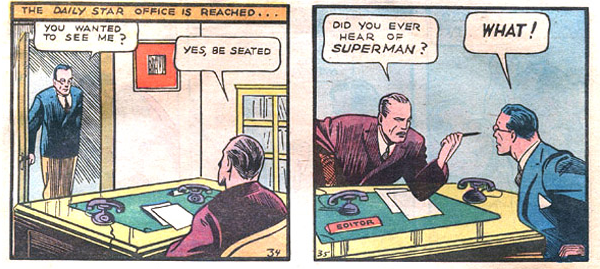
In virtually every version of Superman, Clark is an exercise in patient self-restraint, the ultimate man pretending day by day to be the ultimate common man. In his early days, this restraint was a superstrongman feat all its own, because Clark was extra pathetic—the better for Siegel, Shuster and the readers to identify with him.
I had crushes on several attractive girls who either didn’t know I existed or didn’t care I existed. So it occurred to me: What if I was really terrific? What if I had something special going for me, like jumping over buildings or throwing cars around or something like that?
Jerry Siegel [11]
Kent looked like Shuster, who later lifted weights for five years but never developed the bodybuilder’s confidence.[12] If Kent’s daily humiliations echoed Siegel’s past, they also predicted part of Shuster’s future.[13] When Shuster’s worsening eyesight drove him out of cartooning, he went back to deliveries, showing up at his former publisher carrying a package and wearing a ratty, worn-out suit.[14]
It’s not hard to imagine nerdy Shuster stammering “Sign here, please” in the same voice that Kent used to ask Lois, on their first date, if it wouldn’t be “reasonable” to let a bullying gangster have just one dance with her.[15]
Yet Shuster also drew Clark with a rock-hard physique that threatened to burst out of his jacket and pants at any moment. Every so often, after meekly tolerating an editor’s blustering or Lois’ icy contempt, “Clark” would crack a smile: if only they knew. For him, the angst Siegel and Shuster had felt in real life was just a pose, a suit he put on sometimes. And then he’d hear someone in trouble and strip off his shirt to reveal the S-shield underneath. The red trunks would soon follow. Underwear, for the underself.[16]
It was all just a game. Everything was going to be all right. Superman cheerfully presided over a world of bright rainbow colors where hurts and humiliations were temporary. Indeed, after a couple of years he developed a code against killing—a code most superheroes also followed.[17]
They also imitated the briefs, especially his most immediate peers—the original versions of Batman, Robin, Hawkman, Hourman, Starman, Dr. Fate, the Spectre, the Atom, and the Star-Spangled Kid all rocked the look as seen below. [18] And yes, more than half of those heroes also followed his “Somethingman” naming convention.
The 1960s and 1970s still saw plenty of new trunks-wearers among Avengers like Giant-Man and the Vision, mutants like Magneto, and gods like Orion. The Thing wore only trunks, and the Hulk torn purple pants. Other gods and mutants (Thor, Darkseid, the early X-Men) wore onesies broken up with a belt.[19] Strangely, two X-Men who each disdained the other’s sense of style—Cyclops and Wolverine—went full trunks-over-pants from the 1970s into the 1990s.[20]
This tendency to assign the look to gods and mutants, though, instead of more central figures like Captain America, Mister Fantastic, and Spider-Man, may have been an early sign that it was on its way out. These newer Marvel characters stood out from the first generation by being more fully realized people in their civilian identities, if not eliminating the dual identity altogether. Of the marquee Marvel heroes, only Thor, whose fashions and godly nature made him the exception that proved the rule, was introduced with a Clark Kentish self-denying secret identity.[21]
Superman’s influence continued to erode as the decades wore on. Newer heroes showed less interest in the code against killing or in names ending in “-man.”[22] And costume redesigns left the trunks behind. The X-Men got into black leather for a while, and their later, more colorful costumes still left the briefs out.[23]
Tim Burton’s 1989 Batman film “de-briefed” comics’ second most famous underwear wearer. Batman never went back to the briefs in any succeeding movies: they began to fade from the comics as well, as shown in this sample of Ben Moore’s larger survey of Bat-suits seen in various media, covering the period from 2005-2012.[24]
The look could still show up in the deliberately retro stylings of a film like The Incredibles; despite fashionista Edna Mode’s disdain for capes and insistence that “I never look back, darling, it distracts from the now,” her creations had an old-fashioned flair that matched the traditional values of their wearers, the kind of nuclear family that seemed to headline most sitcoms from the 1950s to the 1980s.[25]
Superman, for many years, seemed content to be a bit old-fashioned. His brand hadn’t been about “cool” for a long time: it was more about safety and stability. The comic-book Superman of 1962 or 1988 was more scientist than slugger, often approaching problems from a cool remove. His peers honored him as the one who came first, and therefore someone who didn’t need to follow the trends. He had, after all, defined them.[26]
Nevertheless, as superheroes and popular entertainment in general grew increasingly impatient with the “no kill rule,” the temptation to challenge Superman for wearing last year’s morals was overwhelming. The movies of the 1970s and 1980s danced around the issue by making Superman’s foes inanimate[27] or leaving their fates uncertain.[28] But many of his best-loved adventures, the ones that could claim to influence his canon, saw him sorely tempted to end a life—or even saw him succumb.
However, this was always an ending for the character as we knew him, as proved by what came next. In one such story, Superman instantly punished himself by giving up his super-powers and retiring.[29] In another, he died along with his foe.[30] In a third, he had a mental breakdown and went on a long journey of soul-searching before returning to duty with an even firmer vow, “Never again.”[31] In multiple stories of a world not our own, a world gone wrong, Superman deciding to kill is his first step toward villainy.[32] And at least once, he used magicians’ stage tricks to fool the world into thinking he’d broken his rule—just to show how terrible a Superman unchecked by restraint would be.[33]
The conservatism is unmistakable but charming. Nearly all fictional franchises create a moral universe that rewards readers for following them, and Superman is no exception. However much he struggled with it, refusing to kill would always be The Right Choice. Other heroes would always look to him for guidance, saluting his cape as if it were the flag. Underwear on the outside of your pants totally works.
The super-briefs stayed on for generations, in comics, movies, TV, Halloween costumes and branded, official kids’ underwear—an incentive to finish toilet training if ever there was one. [34]
And then everyone seemed to reject them at once. In 2011, Jim Lee redesigned all DC Comics’ top-selling characters, giving them the scratchy, slightly self-conscious “edginess” that had made Lee famous.[35] But the artist who had kept Cyclops and Wolverine in trunks now broke precedent. The red of Superman’s trunks shifted to his belt, and its buckle took a shape echoing the chest symbol. The trunks vanished.
I think you have to go for the core elements that are critical to the costume and freely change what looks dated… For me, the red trunks on Superman, you didn’t notice. It gets colored in blue anyhow.[36]
In the same year’s Action Comics, Grant Morrison and Rags Morales emphasized the populist strain in Siegel’s early, Depression-era stories. Theirs was a Superman for the 99 percent, and his costume was the believable result of a reporter’s salary: a screen-printed T-shirt, short cape, and jeans. [37] Morrison explained:
We felt it was time for the big adventures of a 21st-century Paul Bunyan who fights for the weak and downtrodden against bullies of all kinds, from robot invaders and crime lords to corrupt city officials. The new look reflects his status as a street-level defender of the ordinary man and woman.[38]
The filmmakers of 2013’s Man of Steel found the trunks clashed with their concept of the costume as alien armor. Even director Zack Snyder, whose adaptation of Watchmen had featured two trunks-over-pants designs to the comic books’ one,[39] now found himself breaking precedent.
The costume was a big deal for me, and we played around for a long time. I tried like crazy to keep the red briefs on him. Everyone else said, “You can’t have the briefs on him.” I looked at probably 1,500 versions of the costumes with the briefs on.[40]
Who stole Superman’s undies? Morrison takes responsibility for his part in it, Lee shrugs about careless colorists and readers, Snyder bows to the input of unnamed advisors. Their earlier output, though, suggests they had no dislike for the design, just a need to follow popular taste rather than acting as if Superman still shaped it. But fashion, as ever, sends a message about its wearer.
In Man of Steel, the blue is navy, the yellow rusty and gritty. Smallville’s Clark operates without a costume at all. Both versions of Superman are painfully unsure of themselves, closeted, desperate, and far less successful than earlier versions at preventing collateral damage.[41] Smallville averaged one death per episode in each season.[42] Superman’s first TV outing, The Adventures of Superman, averaged none—and lasted six seasons to Smallville’s ten.[43]
Analyst Charles Watson puts the Man of Steel death toll at 129,000, with the last of those deaths by Superman’s own hand.[44] Contrast this with Superman: the Movie, in which Superman saves everyone at risk from a devastating earthquake except Lois Lane, whom he then rescues via time travel. Man of Steel opened in eight times as many theaters as Superman: The Movie.[45] An influential new beginning, and by his old standards, an inauspicious one.
Man of Steel Superman may scream in anguish after killing General Zod, but unlike in the other stories where he crosses that line, he seems to get over it pretty fast. One scene later, he’s cheerfully knocking an Army drone out of the sky. He actually seems more relaxed and happy after the killing is done! No doubt Lois’ approval helps, but even so.
Man of Steel screenwriter David Goyer appears to be weaving some acknowledgments of that issue into its sequel.[46] He would like to assure you that the Superman you remember from your childhoods isn’t gone—he’s just not fully reborn yet.
Our movie was, in a way, Superman Begins; he’s not really Superman until the end of the film. We wanted him to have had that experience of having taken a life and carry that through onto the next films. Because he’s Superman and because people idolize him, he will have to hold himself to a higher standard.[47]
It’s true that Smallville and Man of Steel focus on a young Superman who hasn’t had a chance to become the graceful legend of earlier works. But these have been the portrayals to reach the widest audience in the last decade. [48] Even in current comics, though they have a lighter color scheme and mood, he’s an impulsive younger man with a quick temper.[49] The latest Superman project to be announced, TV’s Krypton, will take place thirty years before his birth.[50]
Put it all together and you’re left with the impression that Superman’s 21st-century caretakers would rather invoke the smiling, life-preserving, cool-headed circus superstrongman than actually show him. Will the next film change that? Will it give him the power and certitude to preserve all intelligent life in his path with a calm soul and a wink at the viewer? Or is that Superman no longer filmable, a relic to be tossed out like a pair of outgrown briefs?
Tights may tell.
[1] 1978’s Superman: The Movie earned nearly six times its budget and spearheaded the only superhero film franchise of the following decade.
[2] Some variation of Super Friends, always with Superman as the headliner, appeared on TV from 1973-1986.
[3] Eco and Natalie Chilton. “The Myth of Superman. The Amazing Adventures of Superman. Review.” Diacritics, 2(1), pp. 14-22. Spring 1972.
[4] Ellison, Foreword to Dennis Dooley and Gary Engle, Superman at 50: The Persistence of a Legend, 1987.
[5] Oxford English Dictionary entry, 2014. Found via Google search, November 22, 2014.
[6] Batman later used gadgets as sort of substitute super-powers, but other figures—the first Atom, Wildcat, and the Spirit, among others—used nothing but ordinary fists.
[7] Jerry Siegel (illustration by Joe Shuster), “The Reign of the Superman,” Science Fiction: The Advance Guard of Future Civilization #3, 1933.
[8] Les Daniels, Superman: The Complete History, 2004, p. 17.
[9] Jerry Siegel and Joe Shuster, Action Comics #1, 1938.
[10] Grant Morrison, Super Gods: What Masked Vigilantes, Miraculous Mutants and a Sun God from Smallville Can Teach Us About Being Human, 2012.
[11] Gerard Jones, Men of Tomorrow: Geeks, Gangsters and the Birth of the American Comic Book, 2005, p. 63.
[12] Tom Andrae with Geoffrey Blum and Gary Coddington, “The Birth of Superman,” Nemo #2, 1983.
[13] Craig Yoe, Secret Identity: The Fetish Art of Superman’s Co-creator Joe Shuster, 2009; Brad Ricca, Super Boys: The Amazing Adventures of Jerry Siegel and Joe Shuster—The Creators of Superman, 2013.
[14] Joe Simon, My Life in Comics, p. 188, 2011.
[15] Jerry Siegel and Joe Shuster, Action Comics #1, 1938.
[16] Alex Ross for Alex Ross and Paul Dini, Superman: Peace on Earth, p. 7, 1938.
[17] Editor Whitney Ellsworth was the driving force behind this rule, as early as 1940, years before the Comics Code Authority.
[18] Art by Jerry Ordway, Who’s Who in the DC Universe #12, 1986.
[19] Tim Leong, “A Venn Diagram of Superhero Tropes,” Super Graphic: A Visual Guide to the Comic Book Universe, 2013.
[20] Art by Jim Lee for X-Men #11, 1992.
[21] Dr. Donald Blake is more complicated than we can cover here,
[22] Wikipedia’s “List of notable superhero debuts” shows a tapering off of such names after the 1960s.
[23] Grant Morrison and Frank Quitely, New X-Men #114, 2001; Joss Whedon and John Cassaday, Astonishing X-Men #1, 2004.
[24] Selected from Ben Moore’s 2012 “Batman Infographic: Every Significant Bat-Suit Ever,” found at Screen Rant, http://screenrant.com/batman-infographic-every-batsuit-benm-144238/.
[25] Brad Bird, The Incredibles, 2004.
[26] Image by Jim Lee for DC Comics.
[27] In Superman: The Movie and Superman Returns, natural disasters are the chief problem; in Superman III and IV, the main villains are destroyed but arguably not truly alive.
[28] Superman II.
[29] Alan Moore, Curt Swan and Kurt Schaffenberger, Action Comics #583, 1986. Source of the image below and the last “Silver Age” Superman story.
[30] Dan Jurgens, Superman #75, 1992. The famous, notorious “Death of Superman.”
[31] John Byrne, Superman #22, 1988; Jerry Ordway, Adventures of Superman #450, 1989; Roger Stern and Kerry Gammill, Superman #28, 1989; George Perez, Action Comics #649, 1989. John Byrne’s last Superman story, and a heavy influence on Man of Steel in terms of who Superman kills and why.
[32] Central premise of the video game Injustice: Gods Among Us, released in 2013, ongoing storyline in the Justice League/Justice League Unlimited animated series (2001-2006) and invoked in the climax of 1996’s Kingdom Come by Mark Waid and Alex Ross.
[33] Joe Kelly and Doug Mahnke, Action Comics #775, 2001. Adapted into a 2012 direct-to-DVD animated film, Superman vs. The Elite.
[34] Photo from http://savinginsalinas.blogspot.com/2011/09/yard-sale-finds.html. Superman has had many adaptations but this was true of virtually all of them until 2011.
[35] Geoff Johns and Jim Lee, Justice League #1, 2011 (image source), and George Perez, Superman #1, 2011. Lee’s career goes back to 1987.
[36] WonderCon 2013 panel, “WC13: Jim Lee Talks DC, Answers Fan Questions and More!,” Comic Book Resources, March 30, 2013, http://www.comicbookresources.com/?page=article&id=44604.
[37] Grant Morrison and Rags Morales, Action Comics #2, 2011.
[38] Dareh Gregorian, “Bird? Plane? Superdude!,” The New York Post, July 18, 2011.
[39] Nite Owl wore them in both versions, but Ozymandias picked them up in the movie. Comics 1986-1987, film 2009.
[40] Reed Tucker, “‘Steel’ this movie,” The New York Post, November 25, 2012. Image from Man of Steel, 2013.
[41] In addition to the film itself, see Emma Dibdin, “‘Man of Steel’: Zack Snyder defends Superman’s ‘collateral damage,’” Digital Spy, August 30, 2013.
[42] According to smallville.wikia.com. In some seasons it was as high as three.
[43] 1952-1958; 2001-2011.
[44] Graphic by Chris Ritter, “The Insane Destruction That the Final ‘Man Of Steel’ Battle Would Do To NYC, By The Numbers,” Buzzfeed, http://www.buzzfeed.com/jordanzakarin/man-of-steel-destruction-death-analysis, June 17, 2013.
[45] Box Office Mojo. http://boxofficemojo.com.
[46] Devin Faraci. “Find Out Superman’s Situation In BATMAN V SUPERMAN,” Badass Digest, December 15, 2014.
[47] 2013 speech at the BAFTA and BFI Screenwriters’ Lecture series.
[48] 2006’s Superman Returns was far less profitable and problematic in a different way.
[49] Johns, Lee, and Morrison have confirmed this is deliberate.
[50] Lesley Golberg, “Syfy, David Goyer Developing Superman Origin Story ‘Krypton,’” The Hollywood Reporter, December 8, 2014.
Blog: PW -The Beat (Login to Add to MyJacketFlap)
JacketFlap tags: Grant Morrison, Kibbles 'n' Bits, Top News, Steve Ditko, Add a tag
§ A white, straight man named Grant Morrison said something that wasn’t stupid. I think.
Q: I love that the first issue of “The Multiversity” is full of people of color, from black superheroes and politicians to aboriginal gods and gay geeks. Why did you do this, and does it have anything to do with the super-white superheroes who have made the jump from comics to film and TV?
A: To be honest, it happened quite naturally and wasn’t something I did consciously. A couple of characters were ones I’d created for “Final Crisis” and others were new, but all of them were introduced to play specific roles in the story and it wasn’t until I’d finished writing the first issue that I realized my team of superpowerful, multiversal justice champions didn’t include a single straight white man.
I live in a world defined by a diversity of skin color, sexual orientation and opinion. I think it’s important to reflect the influence of that world in my “art.” An accident of birth has made me what I am — a middle-aged and obviously decaying white dude from the west of Scotland — so I’d never presume to elect myself a spokesperson for any minority or group. I’m not trying to make political points here but I do feel it’s important to reflect a world in the comic books that more closely approximates the world in which I find myself living. And basically, I identify with everyone who ever felt like an outsider.
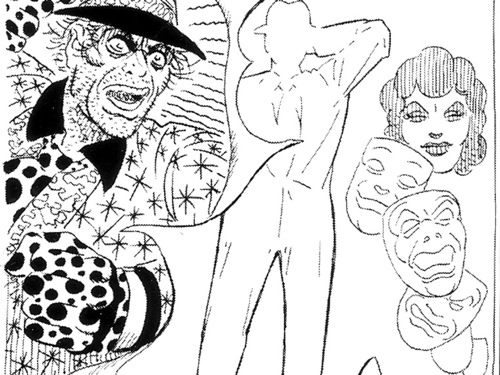
§ Steve Ditko is alive and still making comics…and Kickstarting them. Long time Ditko collaborator Robin Snyder is the enabler here. hey have two 22 page books in the works, #22 and Tales of the Mysterious Traveler. The latter is making his first appearance in 30 years.
§ Speaking of long waits, the second issue of Nate Simpson’s Nonplayer has been finished! It’s been three and a half years since the first issue appeared from Image Comics. Back in 2011, Nonplayer was a beautifully illustrated comic that fit in squarely with the neo-Mobius movement that was taking place. Now Image is awash with gorgeous books, and it doesn’t stand out quite as much. Simpson spent the last three years on his day job in video games recovering from a bike accident and staying up every night until 4 am drawing one precious line a night.
§ The Comics Reporter offers many picks for books that people enjoyed in 2014.
§ Johanna Draper Carlson only blogs once a week now, but she plays catch up looking at some misdirections in comics marketing:
The problem is that so many readers are looking at exactly the same ordering material as the retailers are. Retailers like it when their customers preorder, since that reduces their uncertainty. But to have them do that, they give them the Previews catalog (or an equivalent). There isn’t a retailer-only information channel, so retailers are often left unaware of why a publisher thinks a particular comic will be a big seller if that turns on a plot event (like a death) that the publisher doesn’t want to reveal early. The publisher can’t tell their actual customer because there’s no way to keep the information from going wide to the public. That’s been an issue so long as the direct market has been around. But that’s not what I want to talk about here. (Long digression, huh?) What I want to point out is three examples of material where the publisher can and should have given retailers information that would definitely affect their ordering patterns, but chose not to.
§ Rob Kirby rounds up the rop 10 mini comics of 2014 but throws in many other picks.
§ And going back to the past, Retailer Joe Field passed along this video from 1988 of an interview with the late Marvel editor Mark Gruenwald from WonderCon of that year.
§ SPOILERS SPOILERS SPOILERS. In a recent Marvel comic it was revealed that the Scarlet Witch and Quicksilver are no longer related to a character from another studio. Brett White points out that all this synergy is beginning to break down the things we love most about Marvel.
Blog: PW -The Beat (Login to Add to MyJacketFlap)
JacketFlap tags: nathan fairbarin, pax americana, Process, Grant Morrison, Frank Quitely, Top News, Add a tag
Wow speaking of comics crafts, coloring is definitely one of the key components of today’s comics golden age, yet one of the least understood, and Nathan Fairbairn presents a fascinating process post on how he colored Pax Americana, which has art by Frank Quitely. Among the insights—because Quitely’s coloring on his highly detailed art is so painstaking Fairbairn knew he could never equal it, but he had to try.
Pax Americana, written by Grant Morrison, is part of his Multiversity series, and also a take on Watchmen, and takes on Watchmen by Mark Millar and Warren Ellis. Multiversional indeed. The book has set Twitter all abuzz all week. Quitely’s art is stunning (and violent) as always, but the coloring is a powerful part of the effect of the book, dawn to small details of shadows.
And that’s just for starters! There’s a stunning amount of thought and care that goes into doing it right, which is why I usually just fake the hell out of it. On this book, though, I put in the effort.
And by “put in the effort” I mean “eventually asked Frank to do it for me when I couldn’t get it to look right.”
At any rate, this particular shadow was important. Frank told me he wanted the peace flag to cast the shadow of a mask on Harley’s face, which, symbolically, is so goddamn brilliant it makes me want to fly to Glasgow and hug the guy.
Blog: PW -The Beat (Login to Add to MyJacketFlap)
JacketFlap tags: DC, Grant Morrison, jim lee, Top News, the multiversity, Add a tag
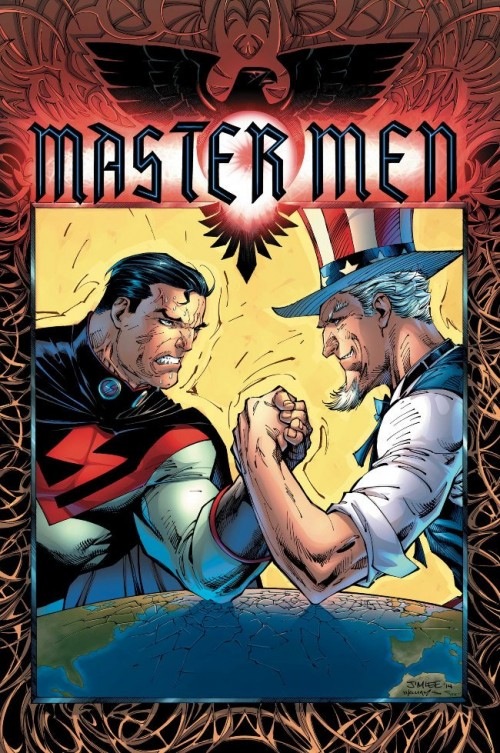
Grant Morrison’s Multiversity mini-series has proven to be an unexpectedly fun rfrolic thruogh the various realities of DC’s multiverses. Well, perhaps unexpected is not the world, since Morrison actually excels at this kind of thing and he’s does it before —Seven Soldiers—and probably will do it again. Actually, since this has been in the works since at least 2009, maybe Morrison already did it before. Tt’s Multiversity—anything is possible.
Anyway, the series continuing with an issues drawn by Jim Lee that takes us to a dimension where The Nazis won. This is the seventh of 8 connnecting one0shots ritten by Morrison with art by various folks, depicting various alternative realities of the DCU. Elsewolrds will never really die, will it?
Uproxx has the advance information:
THE MULTIVERSITY: MASTERMEN #1
Written by GRANT MORRISON
Art and cover by JIM LEE and SCOTT WILLIAMS
1:10 B&W Variant cover by JIM LEE
1:25 Variant cover by AARON KUDER
1:50 Variant cover by YANICK PAQUETTE
1:100 Variant cover by GRANT MORRISON
On sale FEBRUARY 18 • 48 pg, FC, $4.99 US • RATED T
Superstar writer Grant Morrison joins legendary artist Jim Lee on Earth-10 for one of the most dynamic, action-packed issues of this entire world-shattering series – THE MULTIVERSITY: MASTERMEN!
Imagine a world where the Nazis not only won World War II but went on to direct world culture for the next 60 years with the help of an orphaned, alien super-weapon known as Overman! But hope is not lost! Rising from the ashes of oppression are a diverse band of heroes raging against the fascist regime – a band of heroes known as THE FREEDOM FIGHTERS!
What nightmarish parallel worlds haunt the dreams of Overman? Who is the mysterious figure called Uncle Sam? And when the dust settles, will the actions of Phantom Lady, Black Condor, Human Bomb, Doll Man and The Ray be enough to stop Leatherwing, Blitzen and the other “heroes” of Earth-X?
Learn all this and more in this exciting issue that acts as chapter seven of the critically acclaimed MULTIVERSITY storyline.
Blog: PW -The Beat (Login to Add to MyJacketFlap)
JacketFlap tags: Interviews, Conventions, Process, Image, Breaking News, Grant Morrison, Frank Quitely, Top News, NYCC '14, Jupiter's Legacy, Multiversity, Add a tag
by Zachary Clemente
 On the extremely busy Saturday of this past weekend’s New York Comic-Con, I had the sublime honor of interviewing Frank Quitely (pen name for Scottish artist Vincent Deighan) about his visual narrative process, the cycle of artistic influence, and his once and future work. This was a wild treat for me as Quitely stands as one of my favorite artists in comics. Quitely has worked on We3, Sandman: Endless Nights, Flex Mentallo, New X-Men, JLA: Earth 2, Batman & Robin, Jupiter’s Legacy, All-Star Superman and many more.
On the extremely busy Saturday of this past weekend’s New York Comic-Con, I had the sublime honor of interviewing Frank Quitely (pen name for Scottish artist Vincent Deighan) about his visual narrative process, the cycle of artistic influence, and his once and future work. This was a wild treat for me as Quitely stands as one of my favorite artists in comics. Quitely has worked on We3, Sandman: Endless Nights, Flex Mentallo, New X-Men, JLA: Earth 2, Batman & Robin, Jupiter’s Legacy, All-Star Superman and many more.
Comics Beat: Frank, you’re currently working on Jupiter’s Legacy [with Mark Millar] which is ending after 10 issues?
Frank Quitely: It’s actually two volumes, both five and five.
CB: I see. Something I’ve always loved about your work is how versatile your storytelling can be. Hearkening back to Flex Mentallo, there’s some interesting panel layouts, All-Star Superman is a little more cinematic and straightforward, and We3 deviates a lot. I’m wondering how you approach that you want to train the reader’s eye the way you start talking about the story through your art and panels.
FQ: When I started out, I didn’t know a lot about storytelling because I never got a formal training in comics. It ended up being kind of intuitive and my main thing was about trying to make it clear and interesting. You know, I wasn’t really thinking in terms of narrative flow, it was more just about clarity and trying to make it as good as possible. Gradually, over the years, I just became more interested in storytelling. There was a DC editor I worked with named Dan Raspler – the Lobo editor amongst other things. He was my editor on JLA: Earth 2 and before I did JLA, I did a short Lobo story for them and it was the first mainstream DC thing I’d done; I’d been working for Vertigo and Paradox for a couple years. I sent him the pencils and it was the best thing I’d done up to that point and I thought “he’s going to phone me back and tell me how good this is” and he didn’t phone for a week. I was really panicking by the time he phoned; he started the conversation with “dude, I don’t know how to tell you this…”
Basically what he said was my drawings were really lovely, but my storytelling was really boring. He went through and told me what I should be thinking about and that was kind of a real milestone. As it was, that book never came out for different reasons. For JLA: Earth 2, he made me fax a rough for every page because he wanted to see that I could do art that makes sense in rough with a sharpie, then I could do it properly.
CB: Sort of like doing thumbnails?
FQ: Yeah. In fact, the new version of [JLA:] Earth 2 has those thumbnails in it. That was a big leap for me.
CB: There’s a couple panels I’d like to ask you about, the first from We3. The one where it looks like the panel begins to turn across the page.
FQ: With the cat leaping through?
CB: Yes!
FQ: Grant [Morrison] and I sat together, both of us with pencils, trying to work out a way of doing this. [...] That kind of “turning the panels” was almost like windows that the cat was going though – that didn’t come right until the last minute because Grant was describing something to me but it was like he knew there was something there we could do but he couldn’t quite visualize it. It was just a case of me sitting, drawing stuff and then asking if we were getting closer – it was very collaborative.
CB: Do you think that kind of collaboration is where you find the best of your work coming out?
FQ: Um, sometimes. Sometimes it works that way and sometimes it’s nice just to be left alone and work it out myself. Like in Jupiter’s Legacy, in the first issue there’s kind of cube thing. In the script, Mark said something like “he puts them in this cell” and I got thinking about “cel” as in animation cel as well as “cell” like a prison cell and it just kind of came together very, very organically in a relatively short time. It really goes both ways.
CB: I actually wanted to ask about that panel. It’s beautiful how it breaks down all the way to the linework and builds it back up again. I find it an interesting visual discussion on comics.
CB: Changing gears a bit, I’m curious about your influences. Not necessarily artistic influences, but what comics have influenced the way you want to do comics, the way your approach working on comics?
FQ: An early one was Hard Boiled by Frank Miller and Geof Darrow. I set out when I was maybe 20-something and when I saw that, I was really blown away by that. More recently Chris Ware’s Building Stories, it’s a masterpiece – the guy’s a genius. I’ve gone plenty – Akira, the big black and white collections of Akira. Moebius, particularly [his] short stories.
CB: The sheer breadth of his influence is remarkable and that’s something I wanted to touch on with you. In my opinion, you and your work occupy a peculiar place in the comics “family tree” where your catalog is intensely influential for many contemporary creators, but it’s not like you’ve gone away, you’re still pushing yourself. Do you find yourself in something of a loop, being influenced by people you might have influenced?
FQ: Oh, yeah.
CB: What is that like?
FQ: It’s really cool. It’s actually really cool. Two artist who work I really like a lot who’re younger than me are Amy Reeder and Becky Cloonan and both of them, in some way, found something in my work that they liked and there’s now something in their work that I like. With Amy in particular, she started off at Tokyopop and she was only interested in manga. Brandon Montclare, who she’s working with now [on Rocketgirl], was an editor at Tokyopop at the time and he gave her a bunch of comics that he wanted her to look at to kind of broaden her horizons a bit. When she first saw it, she didn’t like my work at all; there was nothing there that she liked. Brandon told her to ignore that she didn’t like my drawing but to look at was I was doing because I was going about it a different way from her. After a while, she did actually start liking it and that’s the kind of funny thing – she didn’t like it at all at first but once she kind of get into it, she got something from it and now her recent work on Rocketgirl is just phenomenal.
When I see stuff like that, I always feel slightly threatened by a lot of younger artists. Because to me, a lot of this stuff seems really fresh and I keep thinking “shit, man, I’m going to have to up my game.”
CB: Can that be a little thrilling?
FQ: Yeah – absolutely. I don’t want to get to a stage where I’m kind of quite happy with what I’m doing. Like every other artist I know, I see the mistakes in my work more than the good parts. Even things that work quite well, it always looks slightly better in my head. Every page I start I think “this is going to be the best one yet!” So I don’t want to get to a stage where I’m not influenced or threatened by other peoples’ work.
CB: That’s a very remarkable way to stay relevant. Though something I noticed is your lack of online presence. It seems being active on social media outlets is a big part for many comics creators. Is this something that’s never interested you?
FQ: You know, the thing is I can’t answer all my emails as it is, I answer maybe a quarter of my emails or something. So what’s the point of having Facebook? I’m already insulting enough people by not getting back to them. If I had a Facebook presence, I would never talk to anybody – I’d just never get back to them. Either you just that kind of person or you’re not, you know.
CB: Heading to the end, Jupiter’s Legacy will be wrapping up, what’s next?
FQ: “Pax Americana” – one of the Multiversity books at DC.
CB: And are there any dream projects? Characters you want to work on, people you want to work with, or your own stories you’d like to make?
FQ: I have written a bunch of short stories and some of them are thumbnailed. So at some point I want to get a collection out of just my own dumb stuff.
CB: That sound wonderful Frank, thanks for sitting down to chat.
FQ: Not a problem – thank you.
Frank Quitely lives in Scotland and draws some of the most amazing comics around. I encourage you to watch the 30-minute feature about him, part of a series called “What Artists Do All Day” produced by BBC4. His upcoming works are the next 6 issues of Jupiter’s Legacy and an issue of DC’s Multiversity called “Pax Americana.”
Blog: PW -The Beat (Login to Add to MyJacketFlap)
JacketFlap tags: Reviews, Grant Morrison, Legendary, Top News, Frazer Irving, Add a tag
By Matthew Jent
Annihilator #1
Writer: Grant Morrison
Illustrator: Frazer Irving
Letterer: Jared K. Fletcher
Book & Logo Designer: John J. Hill
Genre: Sci-Fi/Horror
“Get this black mass on the floor.”
Annihilator begins with a black hole, but the thrust of its story concerns Ray Spass (pronounced space, as in outer), a screenwriter whose big hits are a few years behind him. He still gets “paid to be weird,” but nearly everyone he meets — his new landlord, his agent, the FBI — is gently prodding him to produce something now, something new.
But like a ray of light trapped by a black hole’s gravity well, Ray’s creative process is slow and stuck. He keeps turning in rough act ones to his agent, unable to get any closer to what his story is really about.
So Ray does what anyone would do. He moves into a haunted house.
Well, maybe. Ray’s not the most reliable point of view character, so those voices, those fleeting glimpses of figures and boots and hands reaching out from the dark? They might be real, they might be ghosts, or they might be his own imagination running away with him.
Hey, I like it when Morrison writes about the Justice League. But I’d much rather spend time in a world like this, where the personal meets the weird. That’s what Morrison does best.
Ray’s screenplay-in-progress, also called “Annihilator,” is about Max Nomax, a prisoner on the edge of a black hole seeking “the cure for death.” Ray’s girlfriend has left him (or died, or disappeared), and Ray writes his own emotional wasteland into the screenplay. When Max meets Baby Bug-Eyes, a walking, talking teddy bear and “artificial emotional companion,” he kicks him across the room.
Ray is writing a story about being trapped at the edge of a black hole from a house with a growing sinkhole in the yard. Ray thinks of himself as Samuel Taylor Coleridge, writing his own unfinished Kubla Khan. Ray’s work is interrupted by a party of prostitutes he’s invited over himself, creating his own obstacles to prevent his self-perceived work of genius from being completed. Because it can still potentially be a great work of art if it’s never properly finished, right?
The meta-masterstroke for this six-issue series would be to release everything but the final issue, freezing it in time. We’ve all heard about Dickens’s The Mystery of Edwin Drood, Gilliam’s Don Quixote, Moore and Sienkiewicz’s Big Numbers — unfinished projects with so much potential for greatness they have their own gravity. But part of their mythology is that they remain undone. They don’t have to stand up to the same kind of critique as finished projects, because their endings live in our imaginations.
Frazer Irving’s art is reminiscent of 90s Vertigo comics, but without the muddy rushwork that could populate some of those monthly books. Ray is drawn as moody and darkly attractive, with a tuft of black curls erupting from one quarter of his otherwise shaved head. The art loops and curves, drawing the eye, possessing a gravity of its own. Sometimes it’s like looking through a distorted peephole or an iPhone panorama picture. Sometimes it’s like being on a rail or a rollercoaster that pulls you along. Sometimes it’s like a shifting floor, using your own sense of balance to push you in the direction you should go.
Irving’s style is a nice mashup of some of Bernie Wrightson, ghost-bear-style Bill Sienkiewicz, and Jim Starlin at his cosmically most alluring, especially when Max Nomax flashes his spooky smile. Even without Morrison’s big ideas, that’s a visual space opera I would sign up for. With Morrison, I’m trusting that Annihilator is going to get even weirder, and I’m excited to see what Irving can do.
Sinkholes. Black holes. A black mass. This is Morrison’s best, most confident book in years.
Maybe the “cure for death” sought by Max Nomax is actually an eternal pause button, becoming frozen in space and time, at least to the perspective of an outside observer. We see the light slowing down, but to the light itself? It crosses over that point of no return. Do you want to be frozen, or do you want to see what’s on the other side?
The light knows things we do not.
Blog: PW -The Beat (Login to Add to MyJacketFlap)
JacketFlap tags: Marvel, Grant Morrison, Jeff Smith, Alan Moore, Top News, mike allred, Peter Milligan, Joe Quesada, Add a tag
Although the Miracleman reprints by Marvel have more or less been business as usual and not the apocalypse, news of never-before seen Miracleman stories by Grant Morrison and Peter Milligan is still exciting. Vulture has the deets on a new Miracleman Annual #1 which will be out on December 31st and include a long-lost story written by Morrison, now found and drawn by Joe Queseda, and an all new story written by Milligan with art by Mike Allred. The cover is by Gabriele Dell’Otto, and the variant by Jeff Smith.
The Morrison story was unearthed in an article right here on the Beat written by Pádraig Ó Méalóid. Given the long antipathy between Morrison and Moore, it’s a surprising detail but according to Morrison in the Talking with Gods documentary, the story being spiked when it was written in the mid-80s might have been one of the root causes of the feud. Morrison said:
I didn’t want to do it without Moore’s permission, and I wrote to him and said, “They’ve asked me to do this, but obviously I really respect you work, and I wouldn’t want to mess anything up. But I don’t want anyone else to do it and mess it up.” And he sent me back this really weird letter, and I remember the opening of it, it said, “I don’t want this to sound like the softly hissed tones of a mafia hitman, but back off.”
With Miracleman back, Marvel started asking about the story and Morrison requested that Quesada draw it — it’s his first interior art in quite a while.
Milligan’s story is bit nostalgic as well, he told Vulture:
“We’re doing a story that, if you like, looks at the Mick Anglo years, what might be seen on the outside as the innocent, old-fashioned years,” Milligan told me. “There’s a scintilla of self-awareness, with Marvelman being — I don’t want to give too much away, but the story is not without some awareness that it’s all going to change very quickly. It’s an homage. All the guys are there, all the craziness.”
Marvel confirmed that the Neil Gaiman-written conclusion to the Miracleman story—now nearly 30 years in the planning—is still in the works. Finegrs crossed!
Blog: PW -The Beat (Login to Add to MyJacketFlap)
JacketFlap tags: Grant Morrison, Boom Studios, Top News, Add a tag
Boom! Studios has been teasing some kind of conspiracy book about the usual suspects today…
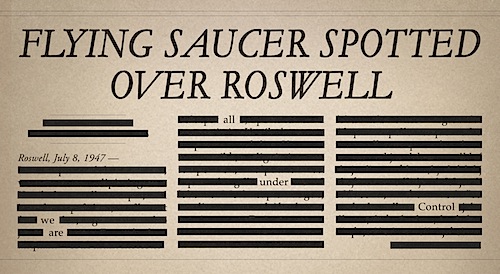

And the first thing I though of was this teaser from the pre-SDCC 15 days of Boom!
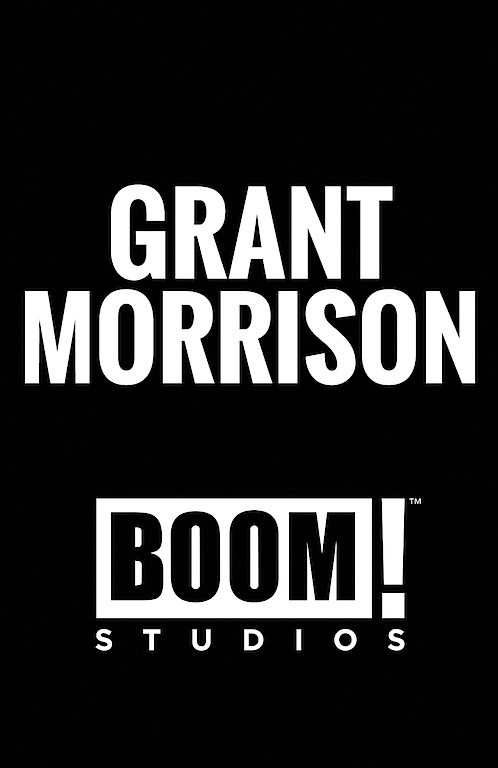
Because is there’s one thing Grant Morrison loves it’s conspiracies and secrets.
BUT Roswell and the Illuminati are pretty old hat for Morrison; been there done that in Doom Patrol.
As Zak Bagans would say, Debunked.
Blog: PW -The Beat (Login to Add to MyJacketFlap)
JacketFlap tags: DC, Breaking News, Grant Morrison, HYPE!, Top News, SDCC '14, Add a tag
Grant Morrison’s got some structure in mind for his upcoming Multiversity series and now we have a map to prove. As you might expect, the map has a serious New Age feel to it. Heaven and Hell show up in the ring around the multiverse along with Heaven and Hell in the “Sphere of the Gods.” The “Monitor Sphere” surrounds the Sphere of the Gods. Is that as in The Monitor and the Anti-Monitor (who’s recently turned up again)? An excellent question. The Rock of Eternity sits below the “House of Heroes” in the center.
Entertainment Weekly has the announcement.
Blog: PW -The Beat (Login to Add to MyJacketFlap)
JacketFlap tags: Comics, Breaking News, Grant Morrison, Boom, Top News, SDCC '14, Add a tag
by Zachary Clemente
With SDCC being only a day away – Boom! Studios teased us with their 15th convention announcement on twitter:
We have no inkling what the project will be as of yet, but undoubtedly we’ll hear more about it during the con. Stay tuned!
Blog: An Awfully Big Blog Adventure (Login to Add to MyJacketFlap)
JacketFlap tags: Neil Gaiman, George Orwell, comics, Grant Morrison, Judge Dredd, 2000AD, Alan Moore, Warren Ellis, Pat Mills, David Thorpe, Paul Gravett, Leo Baxendale, Add a tag
The founding fathers would turn in their graves. The British Library is hosting an exhibition of publications in a medium once accused of undermining literacy, decency and the very establishment itself: comics.
I haven’t yet visited Comics Unmasked: Art and Anarchy in the UK, which has been curated by Paul Gravett, author of Comic Art, which I reviewed last month, but I have a shrewd idea of much of its contents because of my own involvement in the industry from the 1980s and ‘90s.
 |
| Deadline 3 - which published Jamie Hewlett's Tank Girl |
British comics and their creators have an anarchic spirit. In the late nineteenth century the 'Penny Dreadfuls' were sometimes considered so subversive and dangerous to the Establishment (in fomenting an industrial dispute) that at one point printing presses used for printing them were destroyed by the authorities, as documented in Martin Barker’s book Comics: Ideology, Power and the Critics.
There is a direct line from these through Fleetway’s Action comic to 2000AD, which in the late ‘70s and ‘80s saw the work of Pat Mills and John Wagner produce strips such as Nemesis the Warlock, which satirised corrupt organised religion, and Judge Dredd, which satirised just about everything including a corrupt totalitarian state (although sometimes Dredd seemed as though it was applauding the very summary dispensation of justice which it avowedly condemned).
Action was created in 1975 by Pat Mills for publishing house IPC. Soon banned for its violent content it nevertheless spawned 2000AD, the home of Judge Dredd.
 |
| Jamie's Tank Girl - whom he called a female Judge Dredd with bigger guns on speed. |
These class-ridden, patriotic comics were produced by the ultra-conservative family-owned Scottish DC Thompson publishers, for much of the twentieth century - up until the days of punk rock as staple fare for boys, a deliberate antidote to the previous, anarchic Penny Dreadfuls. Orwell describes them in depth in the article and observes their propaganda value as follows:
“the stuff is read somewhere between the ages of twelve and eighteen by a very large proportion, perhaps an actual majority, of English boys, including many who will never read anything else except newspapers; and along with it they are absorbing a set of beliefs which would be regarded as hopelessly out of date in the Central Office of the Conservative Party.”
 |
| The cover of Revolver 1, which serialised Grant Morrison's deconstruction of Dan Dare |
Common to both is the preoccupation with slapstick humour, fantasy and science fiction as a way of boggling minds and examining present-day trends taken to extremes.
Orwell himself notes the value of Sci-Fi (which he calls Scientifiction) in this fascinating sentence:
“Whereas the Gem and Magnet derive from Dickens and Kipling, the Wizard, Champion, Modern Boy, etc., owe a great deal to H. G. Wells, who, rather than Jules Verne, is the father of ‘Scientifiction’.”
You can even position later writers, influenced by these earlier names, on this spectrum, such as Alan Moore and Grant Morrison on the left, and Neil Gaiman more in centre-ground. Grant slyly subverted Dan Dare himself , imagining him as an older man sadly looking back on the glory days of space empire in the pages of Revolver in the late ‘80s.
The ‘80s was a key time, because it was then that the kids who had been brought up on the Beano and 2000AD hit adulthood and it became cool to continue reading comics. Inspired by Moore’s Watchmen and V for Vendetta, and the American Frank Miller’s Batman: Dark Knight Returns, younger artists and writers gave birth to an explosion of creativity.
 |
| The cover of Crisis issue 3 - probably the closest ever to Orwell's dream of a left wing comic. |
 |
| Pat Mills' and Carlos Ezquerra's Third World War deliberately made very cool heroes out of disabled, black, gay or female characters. |
Crisis was largely Pat Mills' brainchild. Overtly political and radical it ran the amazing anti-American Imperialism strip Third World War, which attacked CIA involvement in central and south American countries, a topic already tackled in comics by Alan Moore's and Bill Sienkiewicz's documentary graphic novel, Brought to Light.
 |
| The cover of Doc Chaos 1 by me, Lawrence Gray and Phil Elliott published by Escape |
Independent creator-owned comics sprang up all over the place, from my own satirical Doc Chaos, published by Gravett's Escape imprint, to Deadline, from Brett Ewins and Steve Dillon, which came directly from a collision between comics and the new House music club culture, the true star of which was to become Jamie Hewlett's Tank Girl. And most of us know what happened when Hewlett met Blur's Damon Albarn: Gorillaz, the first band in history that was made up of comics characters.
 |
| Peter Stanbury's and Paul Gravett's Escape magazine - beautifully designed, arty and hip. |
I must given a special mention to Don Melia and Lionel Gracey-Whitman for publishing Aargh!, Heartbreak Hotel magazine with the supplement BLAAM! Because the mere fact that this anti-homophobic publication could be a comic was testimony to how far the medium had come since the days of Wizard and Hotspur weekly comics in which homosexuality was a heavily suppressed element. Here is Orwell describing a cover image: “ a nearly naked man of terrific muscular development has just seized a lion by the tail and flung it thirty yards over the wall of an arena”.
 |
| Heartbreak Hotel issue 5 cover by Duncan Fegredo |
 |
| The first comic explicitly for black people, Sphinx |
 |
| Repossession Blues from the pages of Blaam! |
 |
| A cover of chaos magick journal Chaos International which shows the use of comics iconography - the exchange of ideas went both ways. |
Alan only went public on this more recently, but Grant overtly used his research in long-running strips such as the intensely surreal Doom Patrol and subsequently The Invisibles, both for DC.
It is not necessary to believe in any of the gods and forces invoked by magical ritual in chaos magick to utilise its effects. The point for all of us was that Nothing is Forbidden, Everything is Permitted, to use Aleister Crowley’s mantra. Chaos magick provided an almost limitless kit of tools to access the far reaches of the imagination. I learned my tricks from a group that met every week in Greenwich, above Bulldog’s café, from the legendary Charlie Brewster, aka Choronzon 666.
I used this massive wellspring of creativity when writing The Z-Men for Brendan McCarthy. Brendan was a maverick comics artist who started work in 2000AD, later becoming like many comics artists a film storyboarder, who was renowned for his psychedelic, mystical artwork.
All of us were also heavily influenced by Dada and Surrealism – this was the premier topic of my undergraduate degree. It is very obvious in Grant’s Doom Patrol - just read my favourite story The Painting That Ate Paris; and how else could you come up with a superhero who is an entire street (named - of course - Danny)?
 |
| Pure anarcho-comics: Hooligna Press & Pete Mastin's Faction File collected from the pages of squatting magazine Crowbar - back full circle to the aims of the Penny Dreadfuls |
I attribute all of their success not just to their supreme storytelling abilities but to their political views and their involvement in anything occult, arcane and extreme, because in these genres of comics, what readers demand is out-there imagination – and it takes some serious head-space distorting tricks to cultivate a mind that can repeatedly and frequently, on demand, to a punishing production schedule, come up with the mind-boggling concepts, characters and storylines required.
These lessons were not lost on the more recent wave of massively successful British writers, such as Warren Ellis and Brian Hitch, the creators of The Authority, (just read Warren Ellis' Transmetropolitan for a taste of his brand of anarchy).
And I believe there are lessons here for all writers and artists who aim at children and teens, that most demanding of all audiences, to help them feed and stoke the furnaces of creativity and imagination.
I could even attempt to sum them up in the following seven guidelines. Bear in mind that these are methods I am suggesting, and in no way am I advocating tackling a particular kind of subject matter. These are ways of researching, preparing to write and draw, and of writing and drawing itself:
- Feed your mind with stuff from the far reaches of experience; and apply that to the everyday.
- You can’t be too extreme.
- JG Ballard's maxim: follow your obsessions.
- Never censor yourself – leave it to someone else.
- Boggle minds.
- Maximise drama.
- Above all - don’t take it too seriously.
Blog: PW -The Beat (Login to Add to MyJacketFlap)
JacketFlap tags: Top News, DC, Grant Morrison, Add a tag
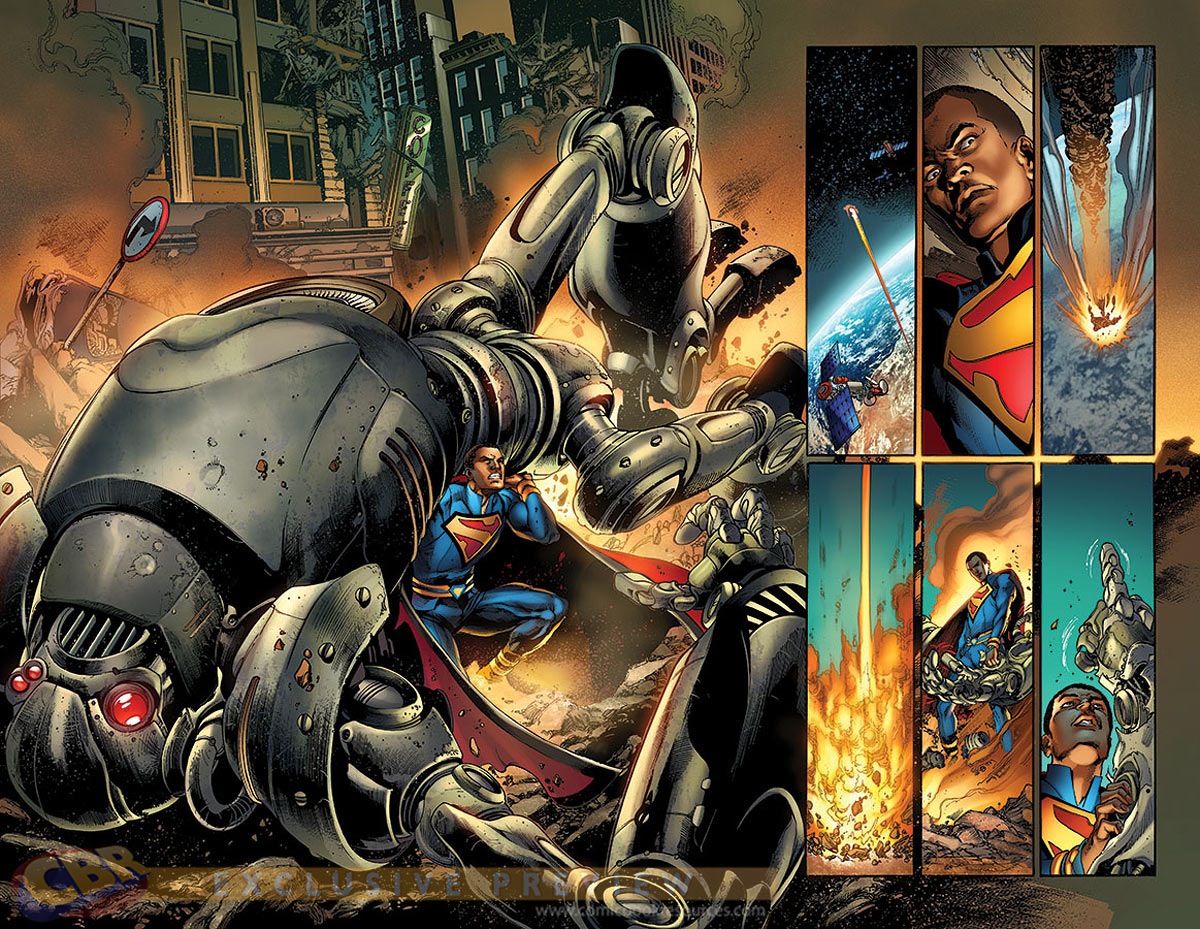
Sometimes the wheels of comics grind exceedingly slow, and Multiversity, a now somewhat outdated multiversical look at the DCU that folds in various timelines, masterminded by Multiverse expert Grant Morrison, is one of those things. It was announced in 2009, and has been biding it’s time since then, even as the DCU it was set to explore got 52ed out of existence. Back in September of 2012, a few Watchmen-esque pencils by Frank Quitely were shown at the DC Comics blog and iFanboy—yes this project has been kicking around so long that iFanboy actually was a website.
ANYWAY, an official pub date has been announced! August 2014! It is happening, CBR tells us with some color art by Ivan Rris and Joe Prado (colors by Nei Ruffino) that has…an odd look to it. Each issues will be 40 pages long Chris Sprouse and Karl Story, Ben Oliver, Frank Quitely, Cameron Stewart and more. Morrison describes the series thusly:
“‘The Multiversity’ has been a labor of love almost eight years in the making, and brings together an unstoppable supergroup of artists — Reis, Sprouse, Oliver, Quitely, Stewart and more — with a cast of unforgettable characters from the 52 alternative Earths of the known DC Multiverse!
“Prepare to meet the Vampire Justice League of Earth-43, the Justice Riders of Earth-18, Superdemon, Doc Fate, the super-sons of Superman and Batman, the rampaging Retaliators of Earth-8, the Atomic Knights of Justice, Dino-Cop, Sister Miracle, Lady Quark, the legion of Sivanas, the Nazi New Reichsmen of Earth-10 and the LATEST, greatest superhero of Earth-Prime — YOU!
Comprising seven complete adventures — each set in a different parallel universe — a two part framing story, and comprehensive guidebook to the many worlds of the Multiverse, ‘The Multiversity’ is more than just a multi-part comic book series, it’s a cosmos-spanning, soul-shaking experience that puts YOU on the front line in the Battle For All Creation against the demonic destroyers known as the Gentry!
But beware! Power has a cost, and at the heart of this epic tale waits the cursed and malignant comic book called ‘Ultra Comics’…
How safe is YOUR head?
Join us, if you dare, for ‘The Multiversity!’” — Grant Morrison
Hurrah! Grant Morrison doing Grant Morrison things! What is not to love.

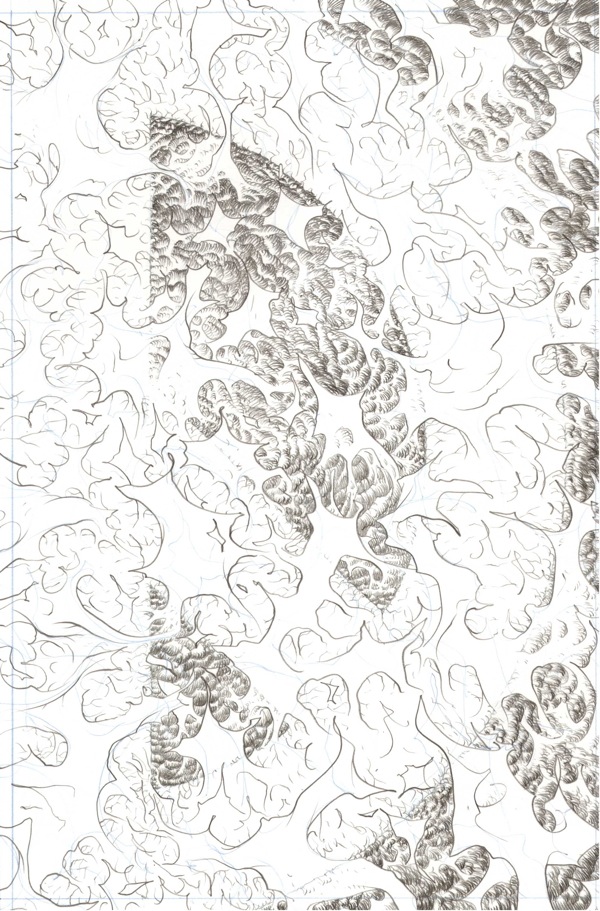
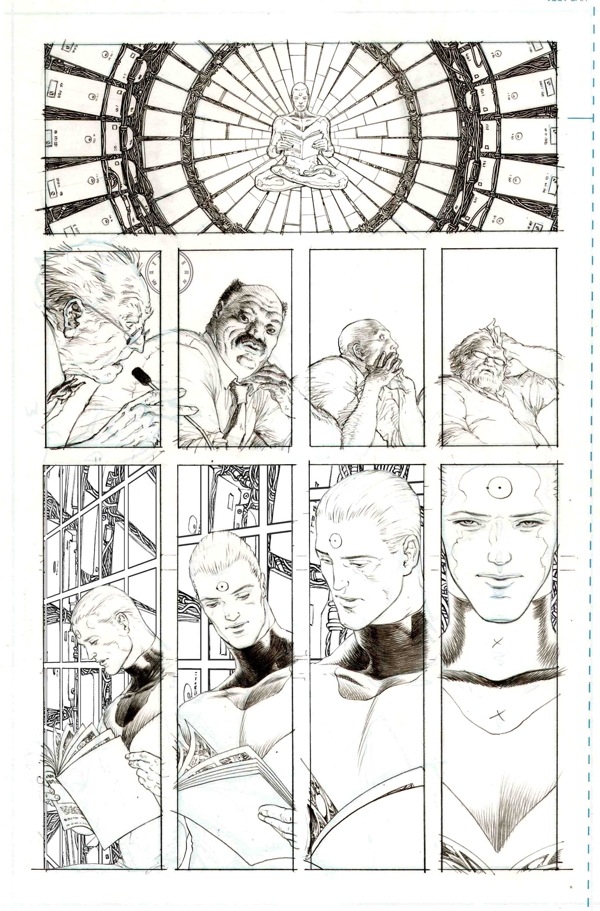
View Next 25 Posts



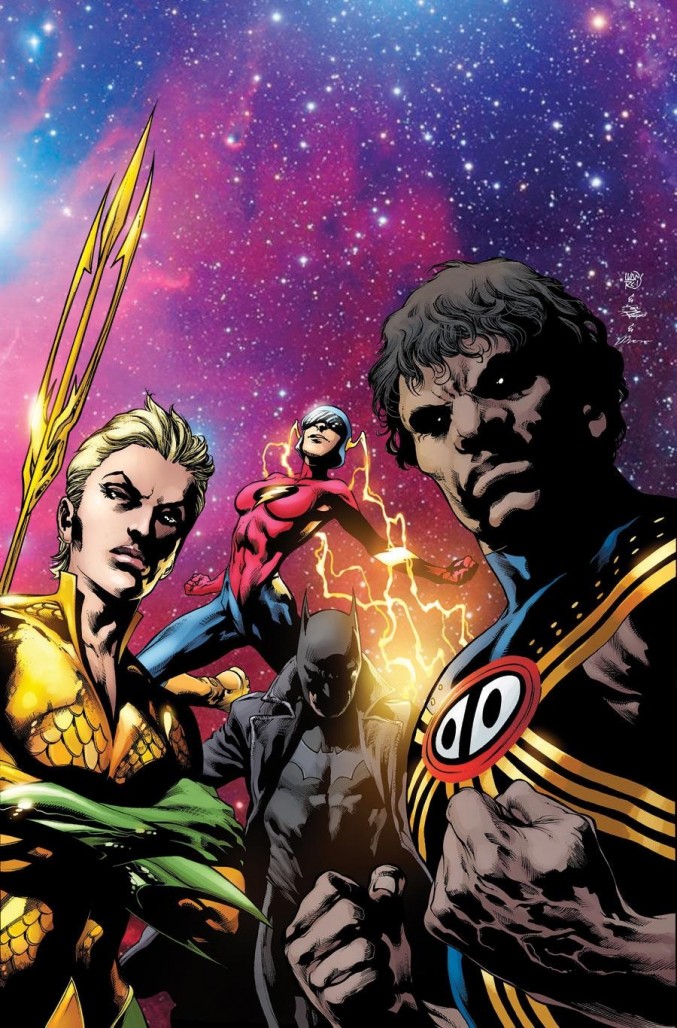
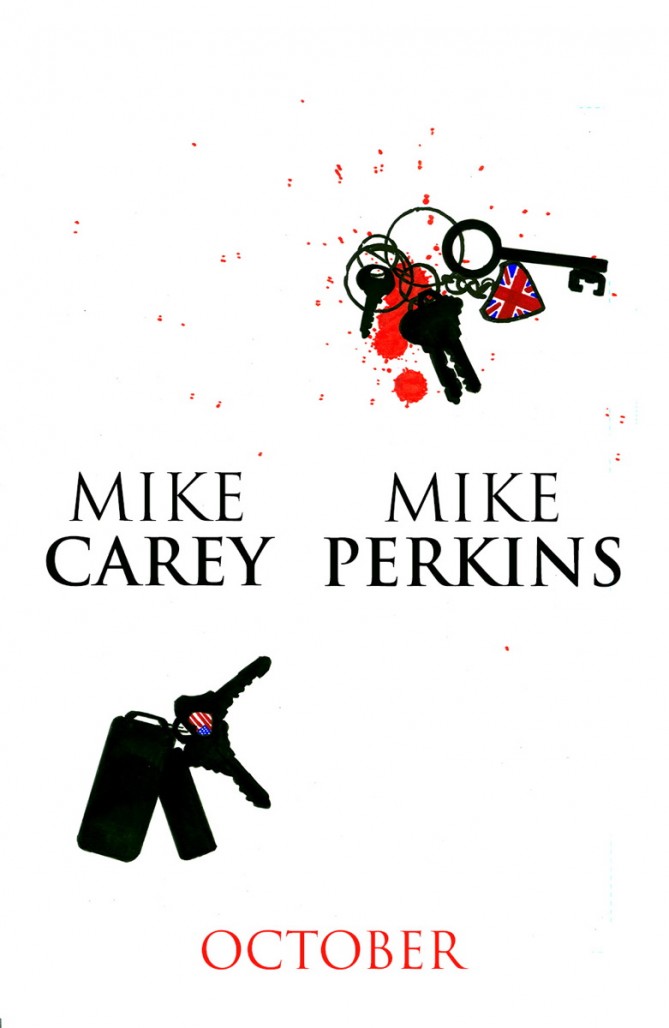
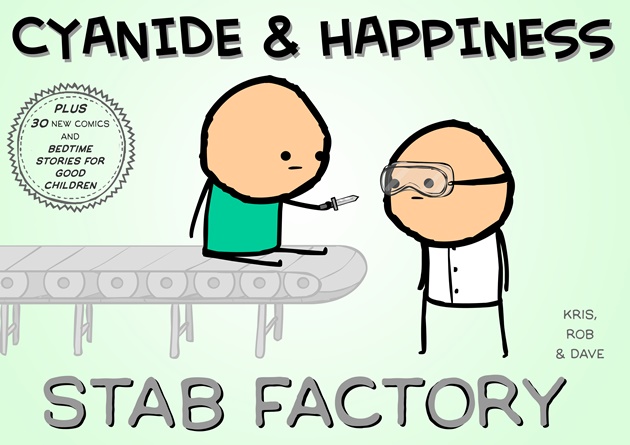
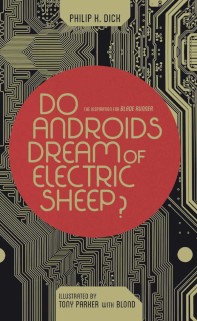
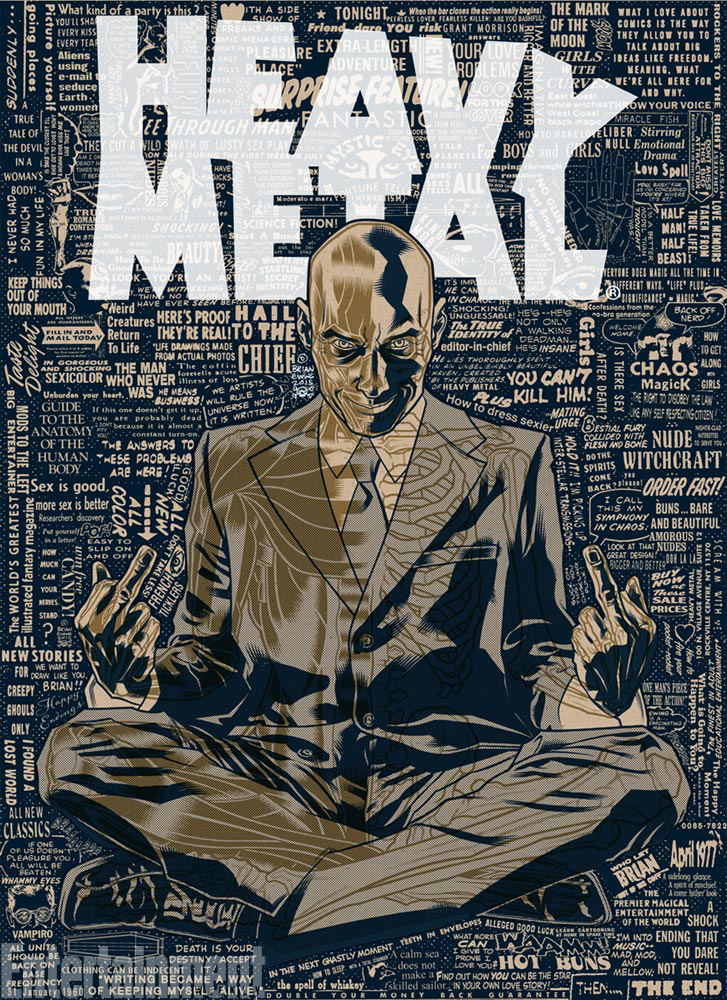


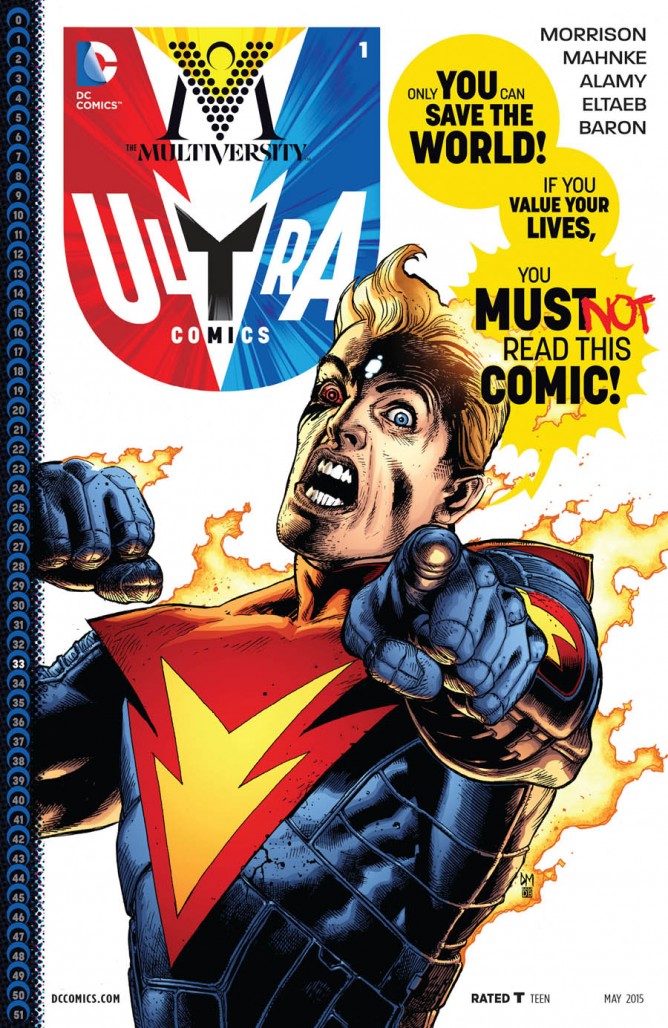
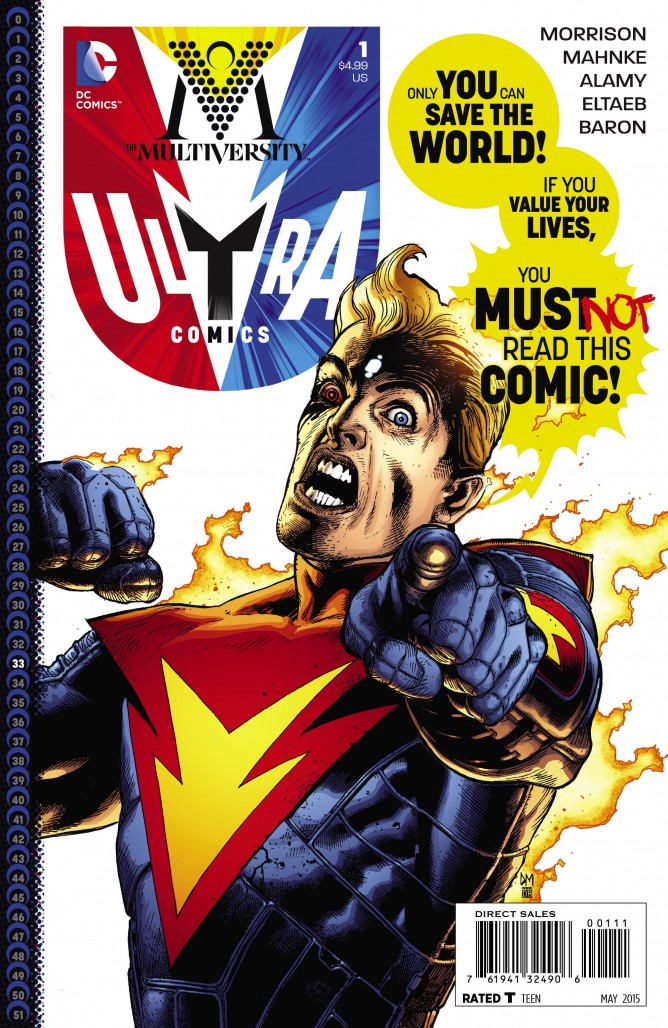
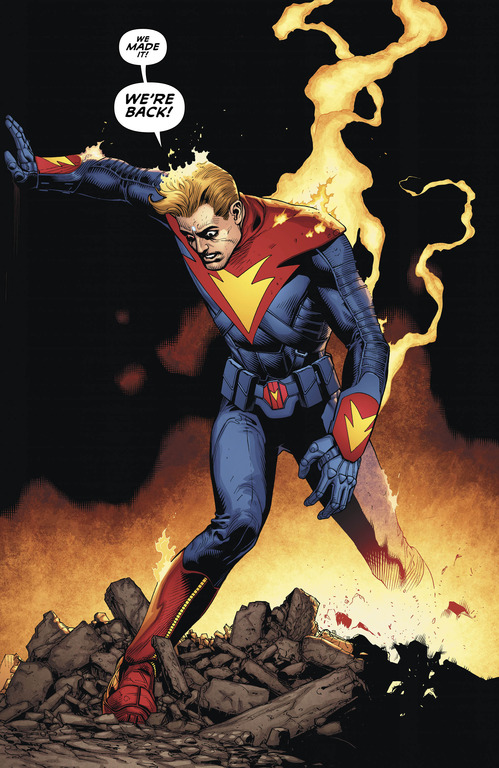
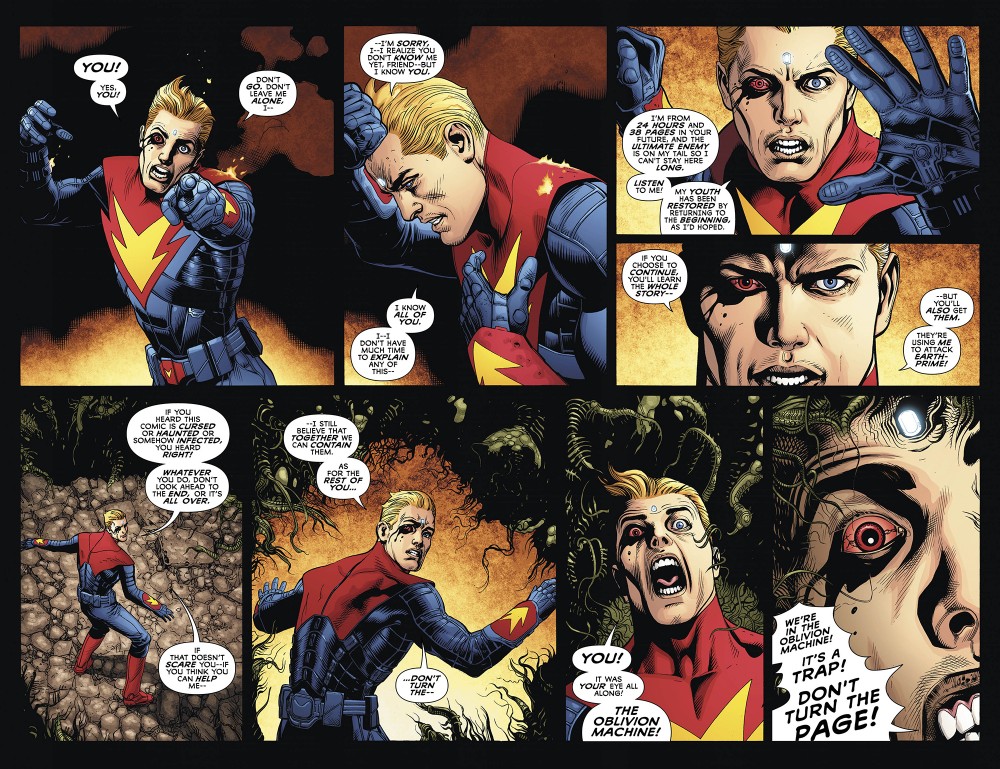
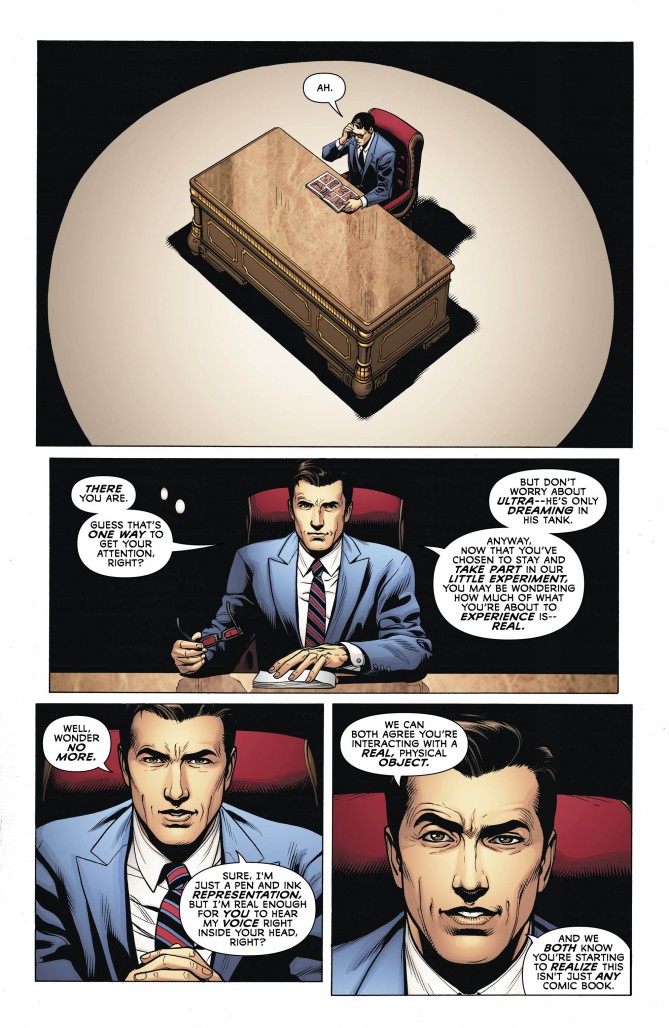
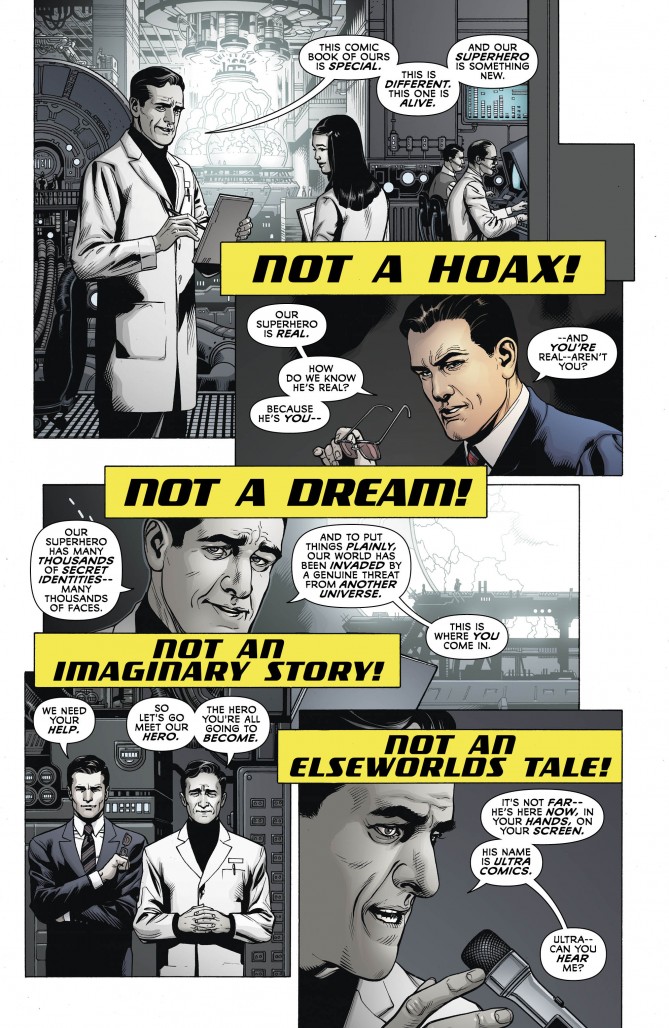
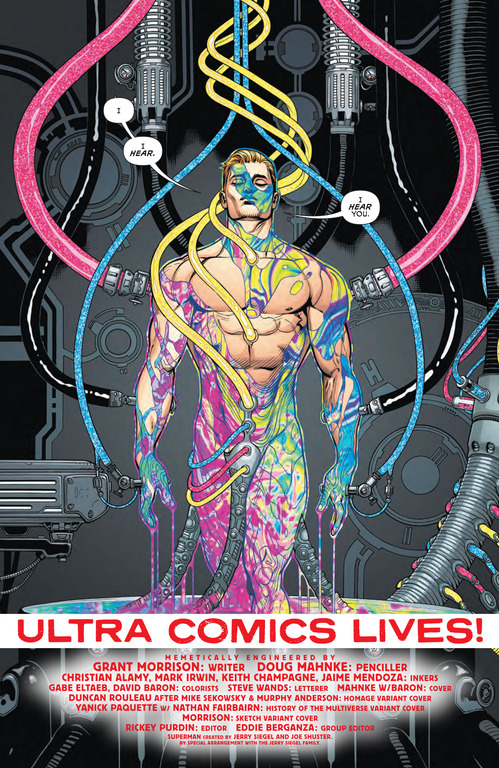
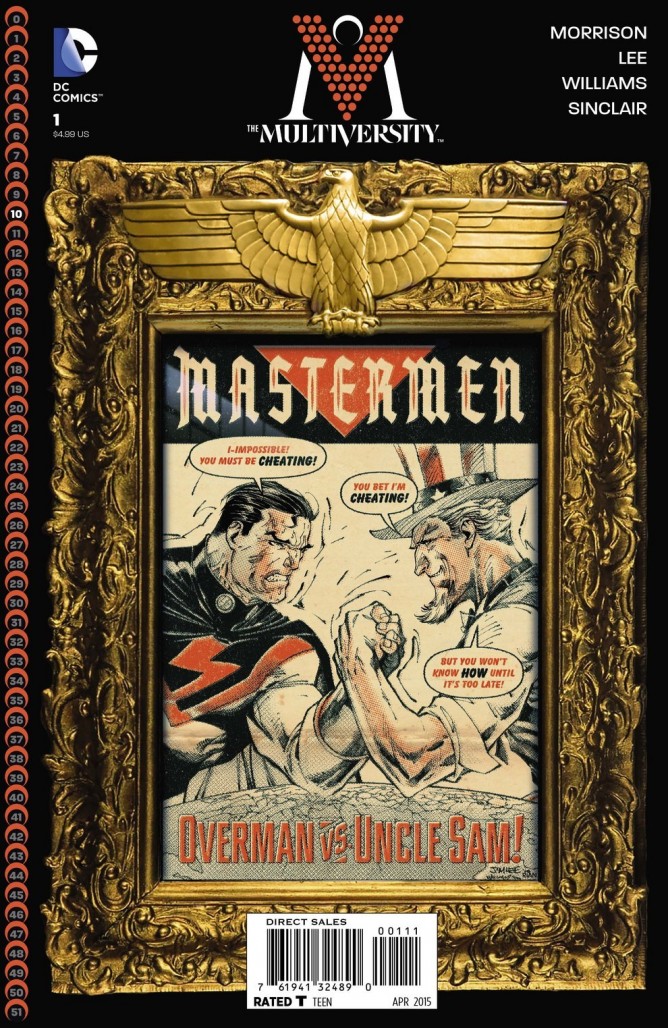
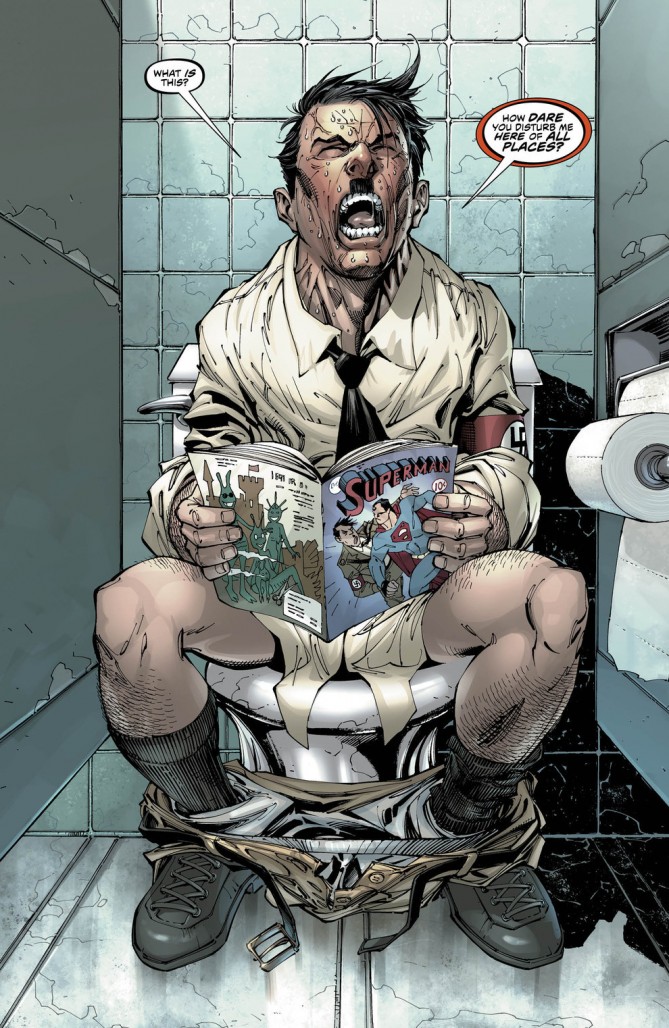
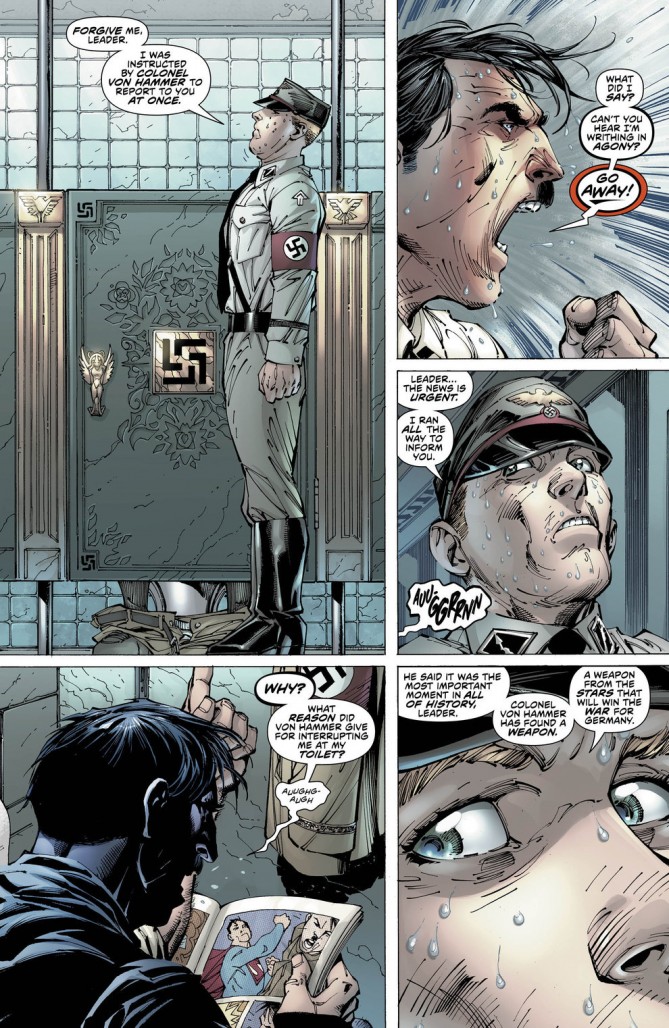
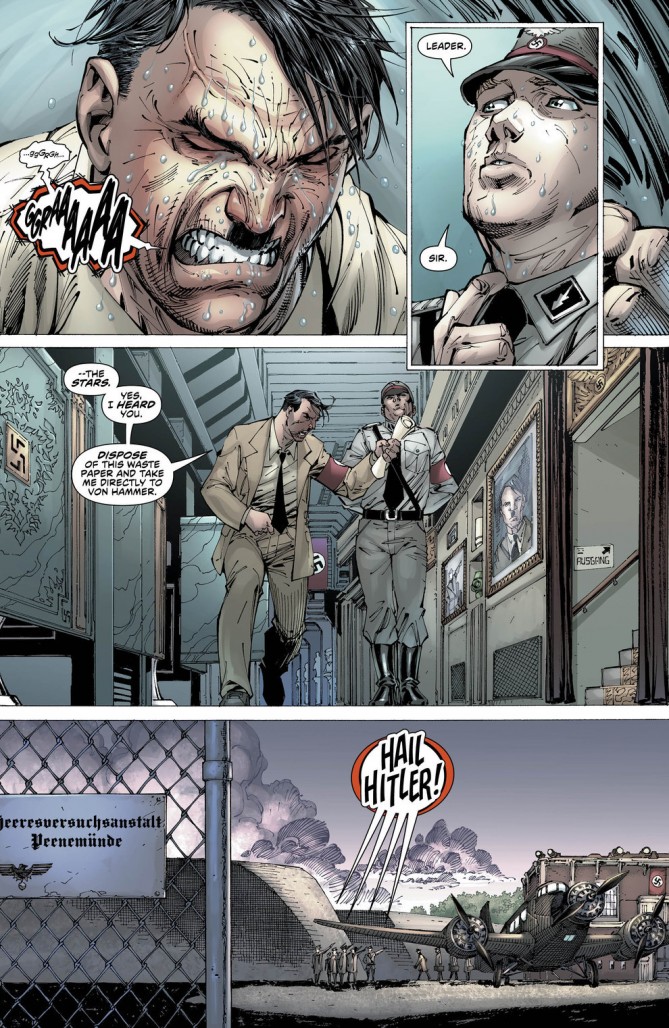
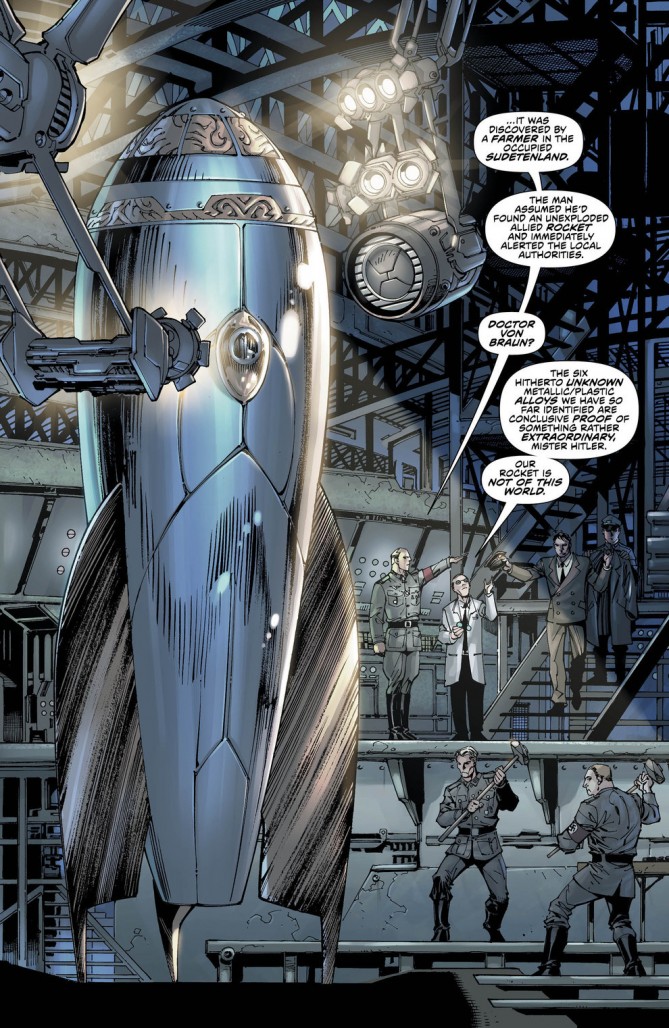
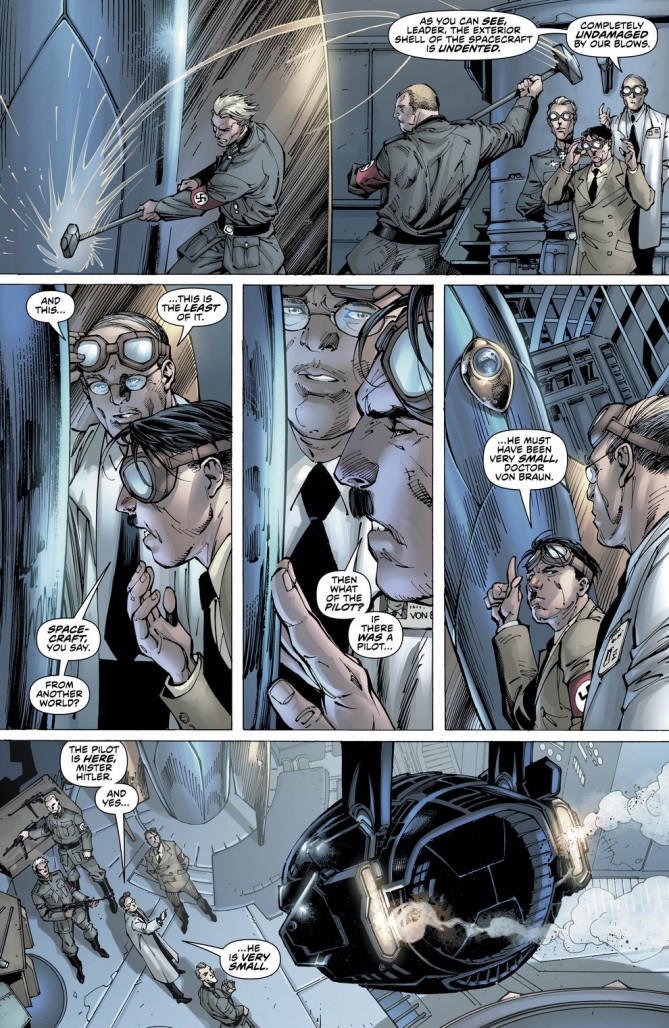
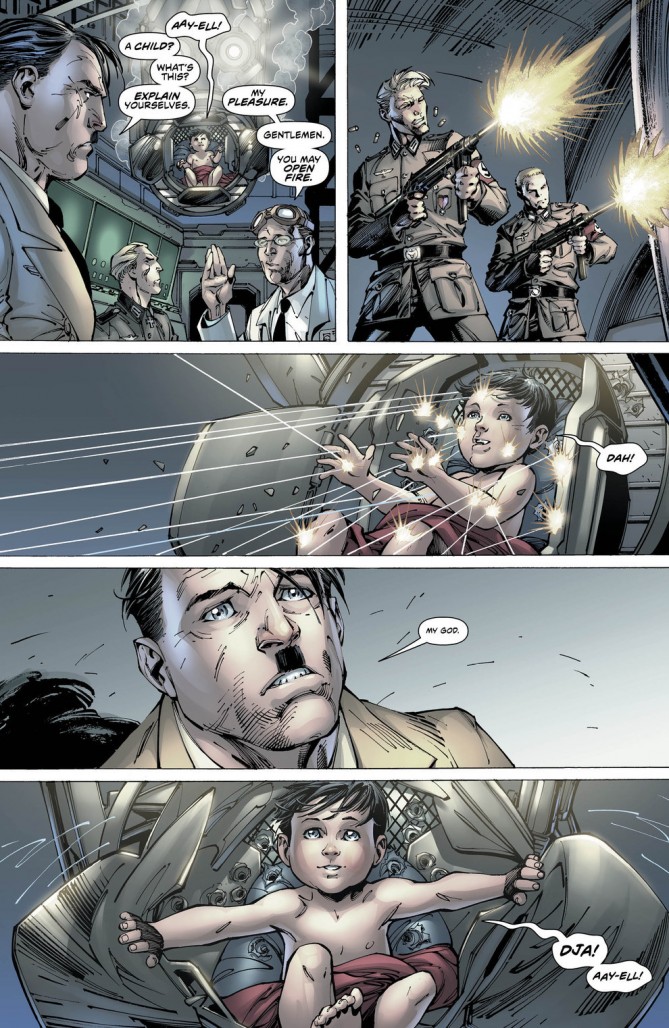
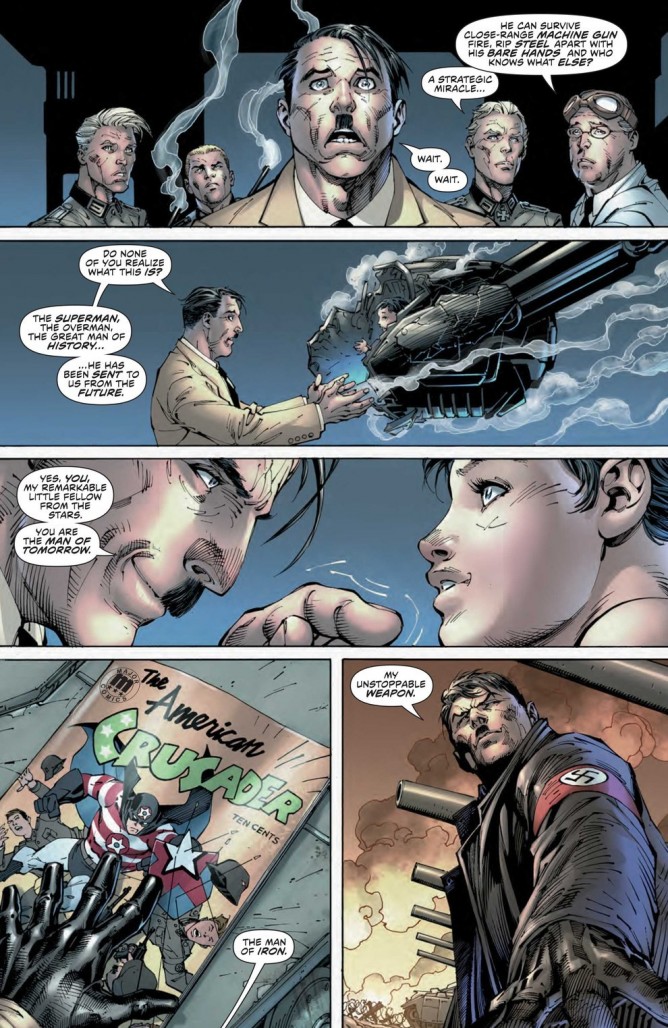
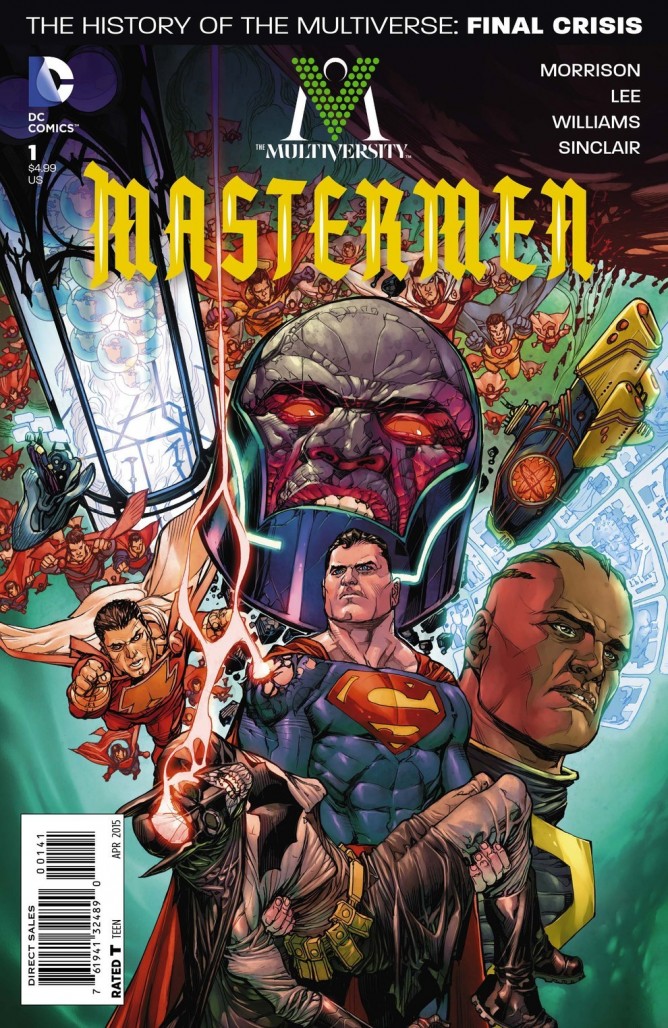
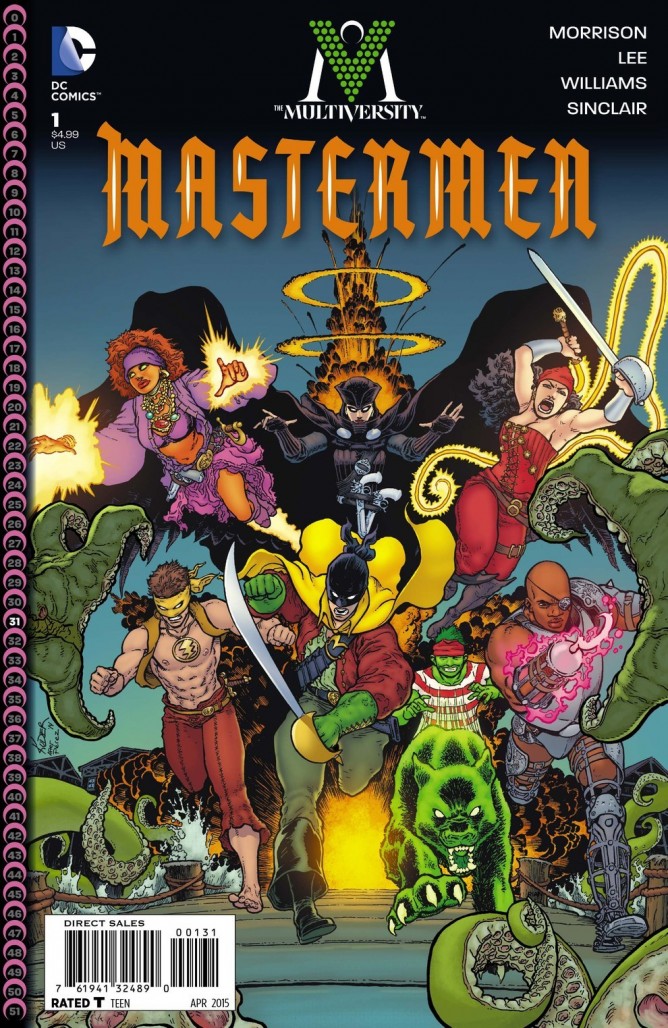
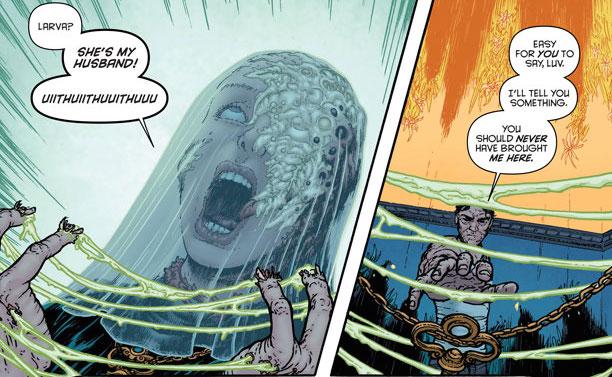
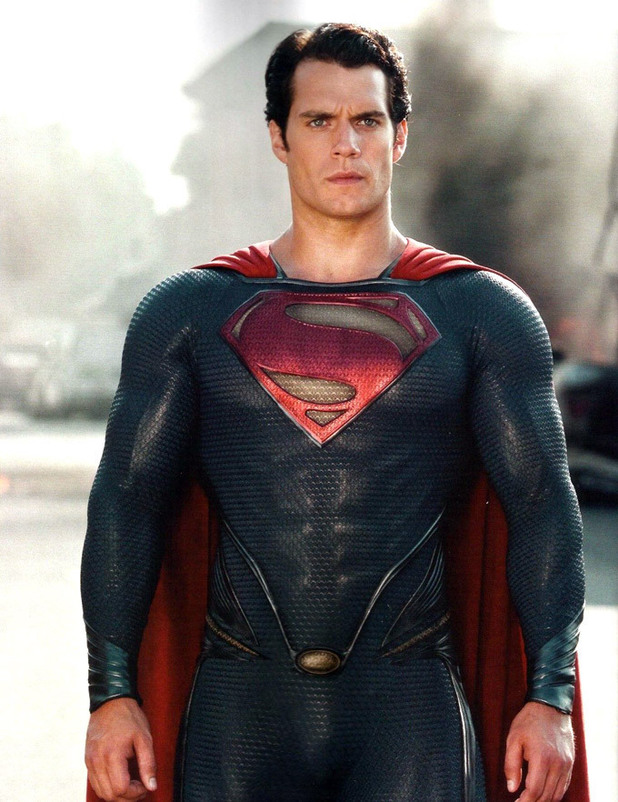

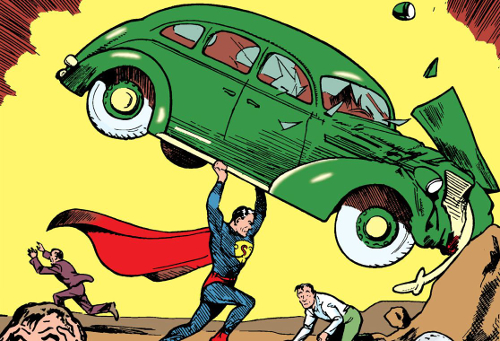

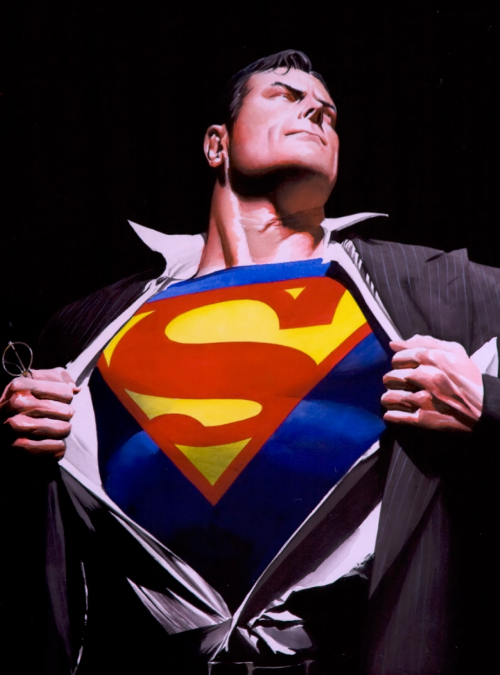



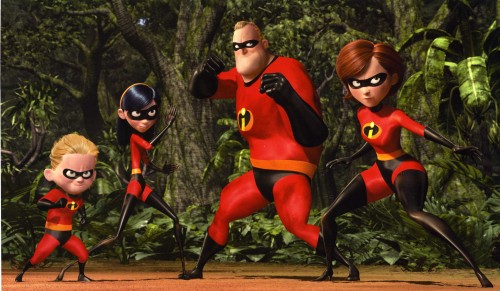






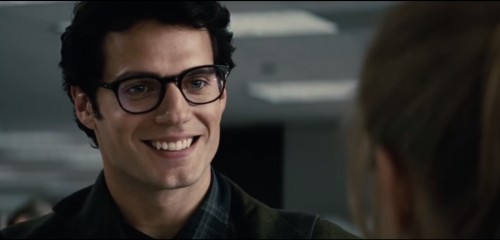
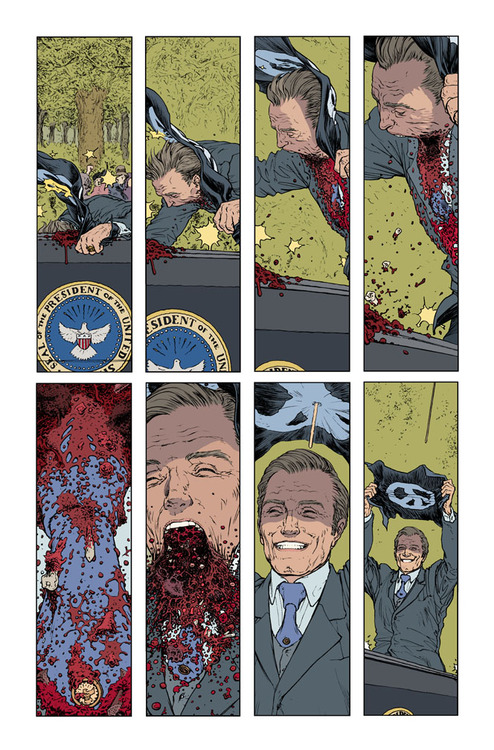

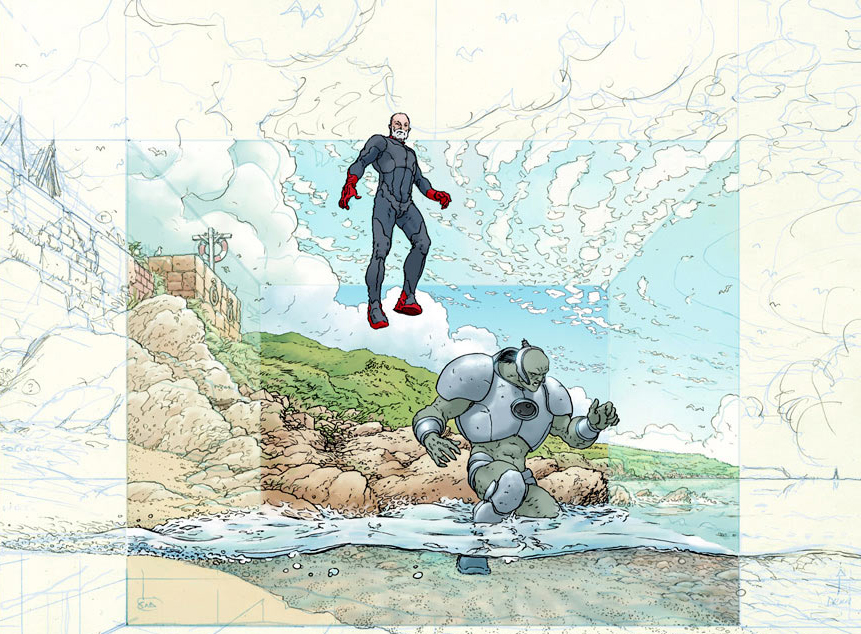
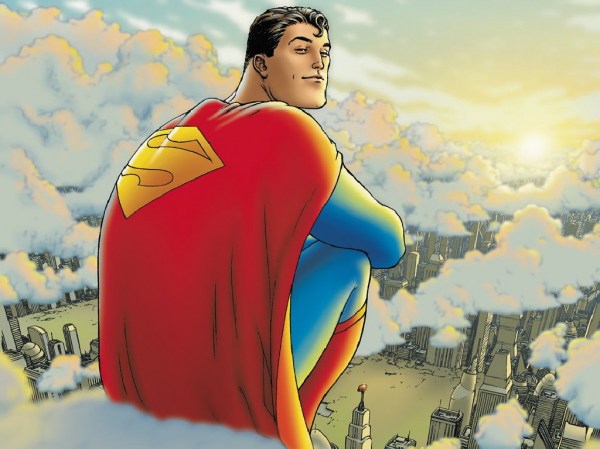
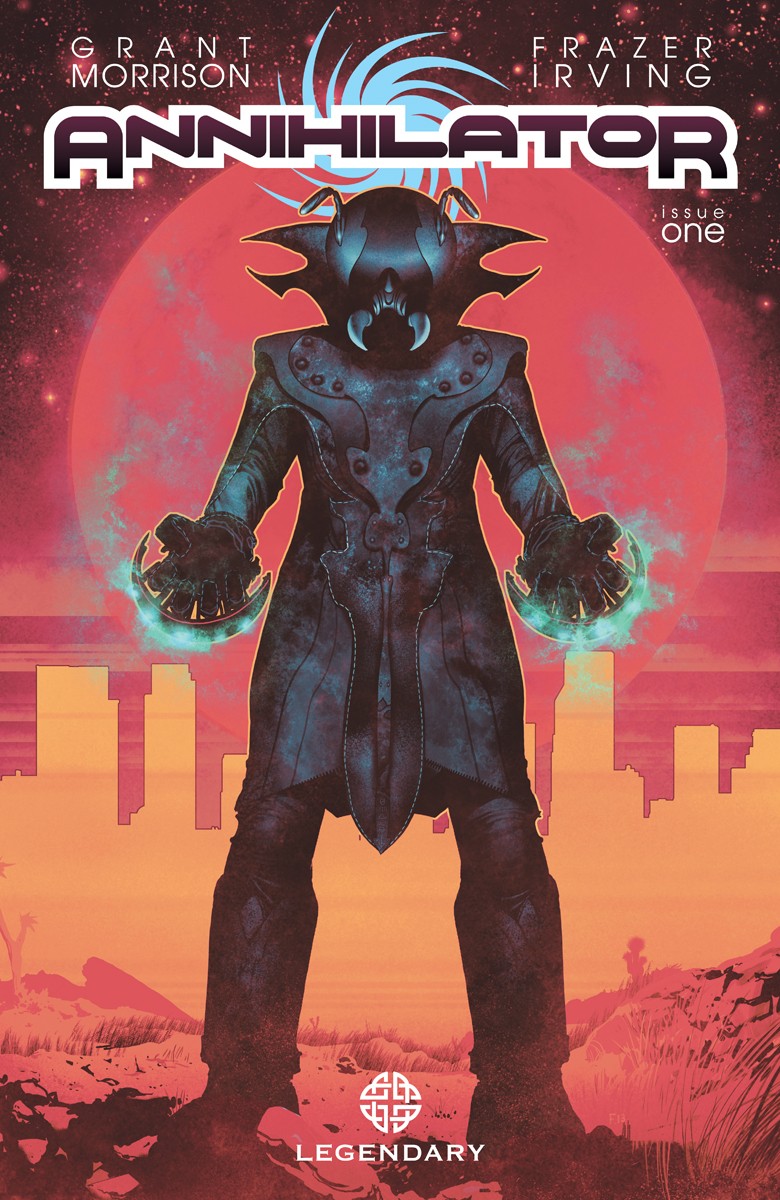

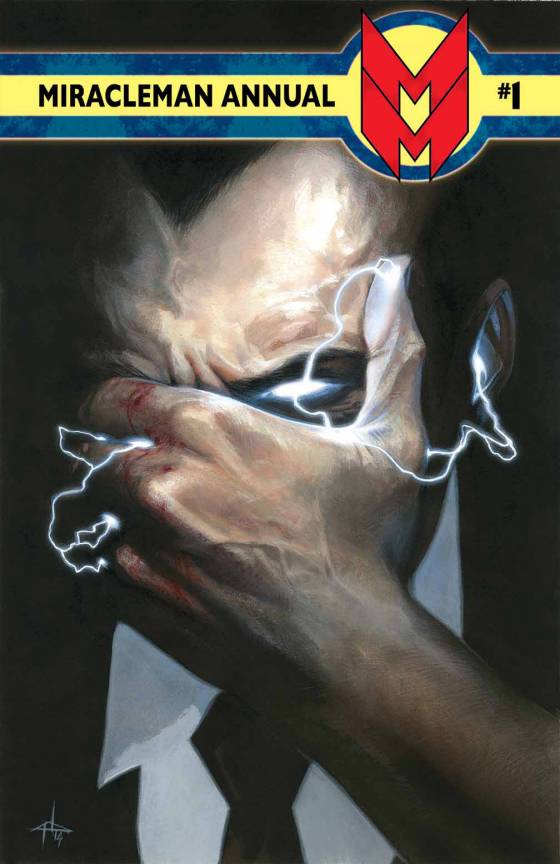
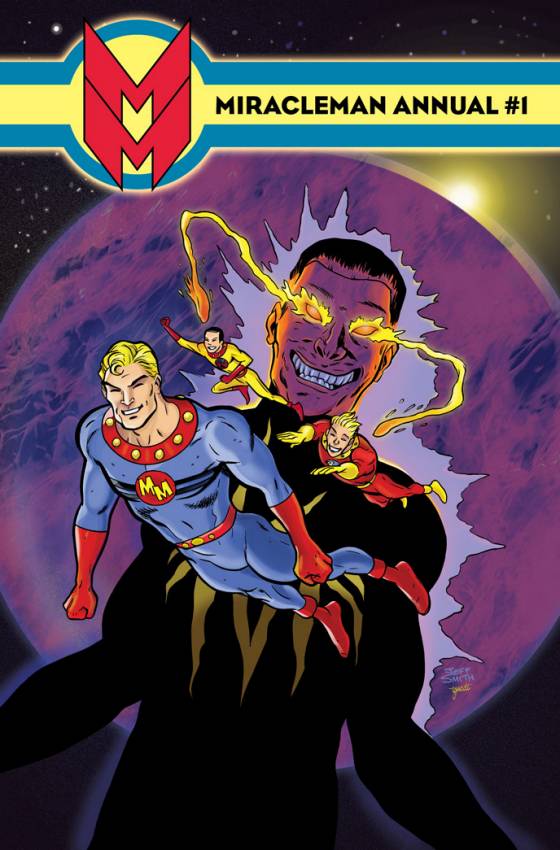
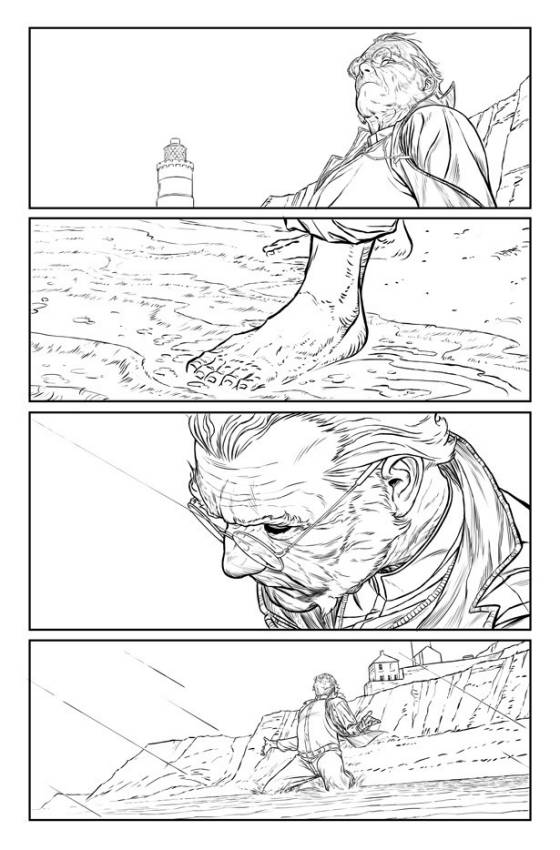

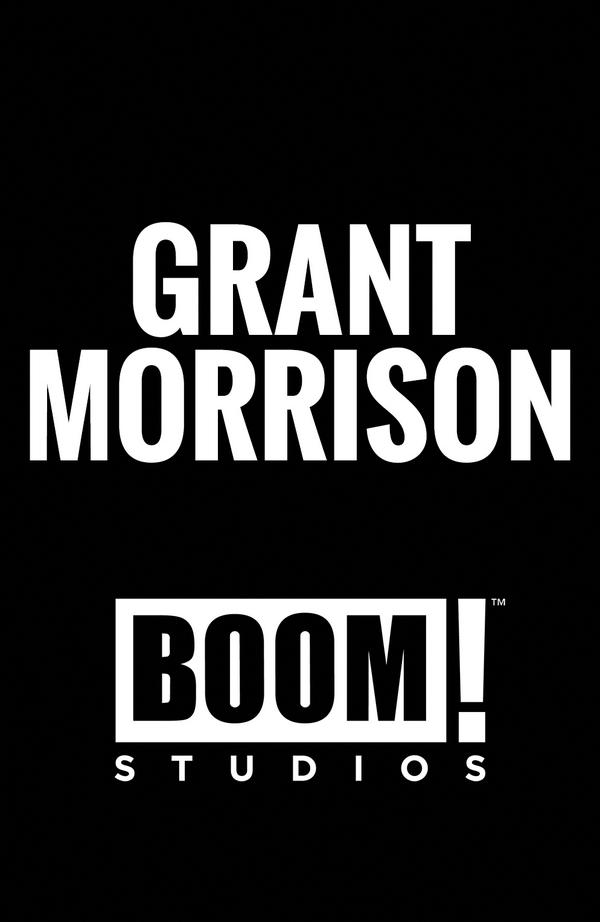
I don’t think this is anywhere even remotely close to All-Star Superman. It was a disjointed, muddled mess. People aren’t treating Final Crisis as one for the ages in the same way they are some of Morrison’s other work, and this will follow that same path.
How’s the binding on this? Typical DC, or the quality sewn binding that occasionally gets used, as in Wednesday Comics? Approximately how much art would you estimate disappears from a double-page spread? Is the map printed across two pages, and if so, is the center part at all legible?
Ralf:
One man’s trash, though I say that as someone who thinks Flex Mentallo is the superior Morrison/Quitely collaboration.
Carl:
Typical DC glued binding. I’d say in most cases it’s not a big problem for my eyes, though you probably lose about 5% of the art on the spreads. The center part of the map is completely obscured though, as it’s printed across both pages. I’m guessing DC realized that when they reprinted the map inside the dust jacket.
Meh, I’ll wait for the absolute edition. I’d still rate this above ASS. That comic while good, is nowhere near as daring as Multiversity and the things it tried to do.
On another front, Ben Oliver stuck out like a sore thumb out of all the artists’. I’m sure a better choice could have been used because his style doesn’t mesh well at all when you compare it with the others.
Off-topic, but atleast he’s better than Esad “omg face” Ribic who is failing hard at Secret Wars. First the time art has disappointed me on an event comic.